#two separate personalities. they visually appear different. but its not a two people one body situation. its one person one body
Explore tagged Tumblr posts
Text
Hey does anyone know any like. Good security breach rewrites w/ Vanessa being the protagonist while keeping her and Vanny as the ‘same person’ (<- wants to see of anyone else has picked up on the missed potential that is the psychological horror of it all) (if not i can and will start going into depth on my rewrite sooner. Because i am deranged)
#i say same person like that bc like. its like a sun and moon situation to me#same body. aware of each other. same person. just split apart#two separate personalities. they visually appear different. but its not a two people one body situation. its one person one body#idk how much sense that makes#scov.txt#fnaf vanessa#vanessa fnaf#fnaf vanny#vanny fnaf#fnaf security breach#thats all im putting for maintags#i’ll take a comic a fic a loose collection of concepts#im exploring this concept in my own au but i would LOVE to see if anyone else has any interpretations on it#most rewrites i see are like. just more cohesive versions of canon and/or copycat killer vanny#and i love the copycat killer aus. dont get me wrong. but those are a lot easier to find
46 notes
·
View notes
Text
the not-insignificant differences between the omen twins
so, i saw this picture posted by @amanaci which inspired me to write this rather lengthy piece on the contrasts between morgott and mohg. i decided that, instead of dumping this whole think-piece on their post, i'd make my own separate post and ramble here.
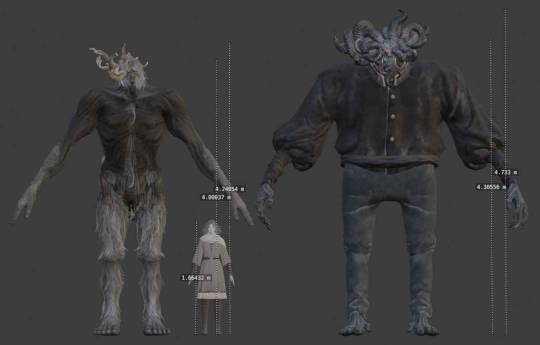
this difference in their height really tracks for how their fighting styles and personalities are like, i feel. i always found it peculiar how different they are despite being twins; i feel like there's a rather stark resemblance between miquella and malenia in their soft-faced features, pale skin, and long flowing hair, and a close resemblance between the carian siblings with their red hair, but morgott and mohg are rather different from each other, only bearing similarities due to their omen nature. i looked a little bit into that and found that there's pretty good reasons behind why.
firstly, morgott is severely malnourished and unhealthy in comparison to mohg. you can see it in his body and how his skin sags, how his ribs and bones show, and how dry it looks. below is a comparison between his hands and mohg's hands.


morgott's hands are dry, almost rubbed red and raw around the knuckles and fingers. it reminds me a little of psoriasis, or some kind of skin discolouration caused by his poor health. it's likely he isn't eating well, or at the very least, he isn't eating as well as mohg. his twin, on the other hand (ha!), has shiny, veiny skin with a healthy colour and gleam to them. it's like he wants to call to attention how well moisturised he is (which, in this case, compared to morgott, he is).


above is a comparison between the twins' horns. the difference is extremely evident to me; morgott's horns are dry, almost seeming brittle, like sun-dried bone that hasn't seen rain or moisture in years. it reminds me of the horns of a very neglected ram, almost, but despite that, the horn growths seem more controlled, less like the wild growths all over the royal omens of the shunning grounds and more controlled as a sort of jutting crown from mainly one side of his head. meanwhile, mohg's horns are shiny, curling wildly to the point of injury, taking his eye in its path of growth. they grew wildly enough to replace his hair altogether, if he ever had any, and give him an even more imposing silhouette with a literal crown of horns (and a beard to boot). beyond this, his horns look healthy, with clearly defined rings to each growth that shine under the light, much like the rest of him. he's oiled leather to morgott's dry hide.

another somewhat interesting detail of morgott is his tail. i know a lot of people see it as soft, and it certainly looks the part, but what i find interesting are two things: the first being that his fur looks quite matted in some lightings and angles but overall looks soft to the touch, and the second being that his tail's horns look much healthier than his own horns on his head. this is in clear contrast to the rest of his body, which looks dry and unassuming with smatterings of coarse white hair up and down his body, and i believe its a matter of the limits to his own self-care. he utilises his tail as another weapon in his arsenal, so he cares for it that it might serve him well in battle, unlike his head of horns, which only serve as a detriment to him with how they must obscure some of his vision, if not most of it. additionally, he likely could bear to look at his tail and care for it, but for an omen that hates his nature more than the average, he probably doesn't enjoy looking at his own face in the mirror enough to properly care for himself.

which brings me back to the sheer differences between these two. morgott, unhealthy and self-loathing, neglects many visual aspects of himself likely because he sees vanity as a luxury not afforded to someone like him. mohg, healthy and self-obsessed, cares and grooms himself to appear very much so like the lord he claims to be, loving himself to a heretical extreme (in the eyes of the golden order). their statures reflect this too; morgott hunches low to the ground, ready to pounce at any given moment but also due to his own shame and humility, while mohg stands tall and proud, though not as tall as he could possibly be due to his upbringing being one of likely having to hunch low to fit beneath the ceilings of the smaller parts of the shunning grounds.

above is a picture of an omen from stormveil, which bears resemblance to all the omen you see in the game. in terms of clothing, one of the big ways people set the omen twins apart, morgott is completely naked save for the ragged cloak of animal hides he wears, signifying he is not fit to even dress himself in a shirt or trousers as befits a king, much like the omen pictured. he wears even less than that, actually, since he lacks even the slightest adornment save for the rope that clasps his cloak together. on the other hand, mohg is entirely adorned in finery, wearing a beautifully embroidered, fashionable priest's robe with matching vestments, and beneath that (as seen in the first image) some underclothes, a plain black button up and some pants. mohg's entire silhouette changes with the removal of his robe, while morgott's barely makes an impact once you realise he has only taken off the one article of clothing he had.
then, of course, there are their fighting styles. there's this fantastic video on youtube that i recommend watching of the twins fighting every major boss in the game, and you can clearly tell them apart from their fighting styles alone. morgott is fast, his size making him look deceptively slow only for him to dart out and do sick flips and somersaults and pirouettes that rival even the most flexible dancers, and he fights with speed and almost animalistic ferocity, save for when he conjures his weapon incantations. mohg is slow but strong, capable of swinging that large trident around like it weighs nothing while hitting with the force to knock down most enemies in a few hits, and most tarnished in just one, but he fights with a steady gracefulness in his every move, walking slowly and carefully while casting spells that hurt a lot.
even their phase 2 transitions are markedly different, with morgott's being one where he drops to his knees, vomits, and releases his cursed blood(?) all over the battlefield, causing his weapon to become alight with his curse and for him to fight with more in-your-face aggression, and with mohg's being one where he simply ignores your attacks and begins stabbing his spear into the formless mother for power at your expense, gaining a majestic set of wings that put distance between you and him so he can cast more of his spells at safer distances. where morgott is pushed to his limit and forced to confront his nature, mohg has long since embraced it and enjoys the fruits of his bloody labour with the mother of truth's blessing.
speaking of the mother of truth, even their patron orders are at odds with each other. the golden order was built upon the foundation of a very carefully-guarded lie: that marika is the one true god, which she can't be, with the existence of radagon (as per goldmask, perhaps the number 1 fundamentalist we meet in game). the formless mother is known also as the mother of truth, existing in direct opposition of the golden order's lies and craving the honesty of one of the purest expressions of life: blood. these two ideals would war against each other, with one being dedicated to the upholding of a beautiful, corrupt lie and the other being dedicated to the instillation of a dynasty of raw, pure truths. as such, even morgott and mohg's own great runes reflect these contrasts in faith, though, remarkably, these two great runes are ones that fit perfectly over each other, with mohg's slightly elevated (seen below, taken from the fextralife wiki).



so, where does this leave us? i don't know, exactly. i wasn't really writing this with any sort of ultimate conclusion. i just found it really interesting how different they were, and i wanted to talk about all the noticeable, significant differences between them here. thanks for coming to my ted talk.
#elden ring#elden ring rambles#elden ring lore#omenboys#morgott the omen king#margit the fell omen#mohg lord of blood#mohg the omen#i hope this whole thing makes sense
636 notes
·
View notes
Text
| Suguru doesn't eat, but tonight he's hungry | smutty smutty smut | tattooed Geto | depressed Geto | kinda poetic | Geto is young and beautiful and not crazy |
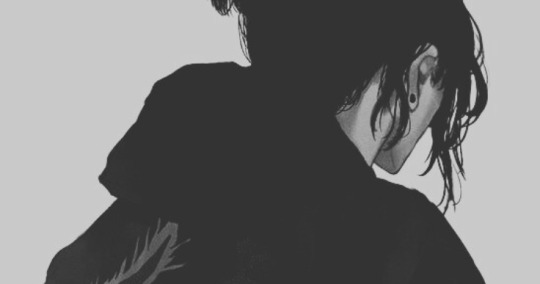
„You haven’t eaten, have you?”
No, Suguru hasn’t eaten.
It’s not like you’re surprised. He’s lost weight - nah, he’s been losing weight steadily for the past few weeks. People say that it’s hard to notice when you see someone regularly, but it’s not hard at all - especially in his case. You’re not sure what’s changed exactly. Suguru still looks relatively healthy, not underweight, but the dark circles under his eyes speak volumes.
You sigh and walk into his apartment. It’s surprisingly neat, to the point it’s a bit scary - so clean it gives an impression as if no living person could function there. And maybe that’s exactly how it is. Maybe that tall, handsome guy in black sweats that greets you is not a person anymore, but a ghost. It’s a question you constantly ask yourself in your head, but never dare to answer. Your heart would break.
„I wasn’t hungry.” A smile appears on his pale face and you sigh again.
You’ve been friends with Suguru since high school, but after your last year you went your separate ways, just to meet again years later - just a few months ago. He didn’t change much, at least not visually - except for his arms. He might have gone a little bit crazy on ink there, and that’s exactly what got the two of you talking again. Tattoos. You’ve never expected Suguru Geto, that sophisticated, awfully smart Geto would cover both of his arms in the most insane pieces of art you’ve ever seen. You’ve had your own share of ink under your skin, but your collection was quite messy and not that cohesive. You liked trying new styles, creating your own map of memories from different places and different artists, while his tattoos were definitely an artwork made by one man. You had a million questions, he was happy to answer - that’s how you ended up in his apartment for the first time. Soon you realised you had a million subjects to go through - politics, art, even God. It was easy, talking with him. It was fun.
And then it began - the movie nights, when the two of you were going through different eras of cinema alphabetically, also bringing snacks that would start on the same letter as the movie you were watching. A stupid idea that you shamelessly stole from „The Barbie Diaries” - the first movie you’ve watched together and the first one that left Suguru completely traumatised.
„Luckily for you, today we’re watching The Notebook, so we’ll be having noodles. What kind of noodles do you want, sir?”, you ask, handing him an invisible microphone.
Suguru chuckles.
„Spicy.”
A few clicks later the food is already on its way and the two of you get comfortable on his huge couch. The projector starts warming up and you look around - it’s completely dark inside and if it weren’t for the fact you know Suguru well, you’d think he made the apartament that way so the two of you could watch the movie comfortably. Your gaze goes back to him - his body hunching over the laptop, fighting with Netflix again.
The projector turns on and the movie starts, as the two of you hide yourselves under the blankets. Unfortunately, you can’t focus. You’re worried.
You’ve had some conversations about his depressive episodes before, so technically you know what he’s going trough, but honestly - you don’t. He doesn’t really talk about it, but if you could get into his head you’d understand how much he values your bare presence next to him. If you could get into his head, you’d know way more, but luckily for Suguru, you can’t. He wouldn’t like that.
In normal circumstances, at least. Because tonight, he is hungry, he is frustrated, and he needs warmth.
And you are anything but cold.
So when he catches your eyes on him, he bets. If you turn away, he’ll let you go. If you give in, he’ll make you stay.
Three seconds. That’s how much time it takes for Suguru to get closer to you and kiss you.
It’s short, soft and sensual, but it makes his head go fuzzy, and when he pulls back he just hopes you won’t run away. Don’t run away. Don’t.
You’re not running.
You’re sitting, legs crossed, just as you were seconds before. Your face is completely red now as Suguru’s eyes scan you carefully, desperate to see the future. Will you go? Will you slap him?
„Why did you do that?” Your own voice doesn’t even sound like your voice. „The Notebook” in the background is now completely forgotten, the flickering lights on the screen keep on changing and throwing different shades on Suguru’s pale face. You didn’t expect that. Not that you didn’t want to or think about it, it’s just…
„I’m hungry” he whispers, and the way his voice sounds gets shivers sprinting down your spine. „And the food’s not here yet.”
„Yeah. It’s not.” He still keeps his hands on your cheeks, right thumb gently brushing your skin, touch light as a feather.
„What are we going to do about it?”, he murmurs, words are barely audible. He’s waiting. There’s another unspoken question hanging between the two of you, and you’re the one who needs to answer.
And that’s exactly what you do.
Both of your hands are suddenly gripping onto his hoodie as you lean into him, lips crashing yet again, just with much bigger force this time. Suguru’s breath shakes as he finally comprehends that he won the bet and a smile crawls onto his face. You’re kissing him. His ray of sunshine. Well, maybe not his yet, but when he’s done with you, that’s exactly how you will be.
And that’s exactly what he does.
His lips travel down your jaw, stop for a second under your ear and then go straight to your neck as your hands let go of his hoodie and find their way to his hair, gripping desperately on the black strands loosely caught in a bun. He groans at the feeling as he bites the skin of your exposed collarbone, his fingers playing with the hem of your blouse, eager to feel more and more of you. Suguru looks up and tries his best not to moan at the sight of your face, your lipstick completely devoured.
„Can I?”, a hoarse whisper leaves his throat, but it’s not even a question. He’s begging you.
And you let him.
He takes his own hoodie of as you take off yours - and you can see them again. The artwork on his arms. You lean your body against the pillows on the right side of the couch and Suguru gulps. He’s been imagining that for a while now, but the reality, for the first time in fucking forever, was so, so much better. His lips go back to sucking and licking your skin and by the moment he reaches your breasts you whine. His hot tongue plays with your nipples, making you impossibly wet, and the bare sight of him shirtless in those awfully beautiful sweats is not helping at all. A part of you is relieved - his muscles are still there, tensing a bit with every movement. And when he pulls away for a moment, you notice it.
„You’ve got a new one.” A koi fish, on his ribs, drawn as usual in a traditional style, this time with a bit of colour. Red. Your favourite. Your hand is shaking, but you can’t help yourself. You trace the shape of the tattoo, his hot skin under your fingertips feeling like fire. You are in awe - even more when you look at him again, breathing heavily. A god. He looks like a god.
And then he proceeds to make you feel like you’re nowhere but in heaven.
He’s not hungry anymore - by the time you’re completely naked he’s starving. His name escapes your lips when his grip on your thighs gets tighter, and then it hits you - his tongue finally making contact with the place you needed him in so desperately. Your hands find his hair again, pulling it relentlessly when he inserts two slender fingers inside of you, at the same time licking your clit. Suguru’s ravenous. You could be his breakfast, his lunch, his dinner, his dessert - everything. He could eat you out all the time, no breaks, no thoughts, no objections. He tries to control his own hips that have been grinding into the couch for a while now, but the feeling of you on his tongue isn’t making it any easier.
„Suguru…” your voice comes back to you, a familiar feeling slowly building up inside of your stomach. „I’m so close.”
You really are, and your clouded mind is making the sensation almost unbearable. Suguru groans yet again, happier then ever, and then you hear it.
„Come for me, baby.”
So soft. So simple. Not a demand, by no means. An invitation - to fall apart on his tongue.
You take it.
His name leaves your lips as your orgasm blinds you, back arching as you pull his hair so hard he groans. Suguru doesn’t stop right away - he makes you ride it out, drinking you like holy water. You shake and quiver and he thinks that maybe that’s exactly what it is. Holy water on his tongue.
And so you lay, completely fucked out under his perfect body, and when he goes up to look at you he’s almost sure he’s going to come right there, in his pants. You’re so perfect. You’re so perfect. You’re so perfect.
„Fuck.” It falls from his lips as he’s taking these damn pants off and you gasp. „I just… Fuck.” He runs his hands down his face, your arousal glistening all over him. It’s like he shines. You might be going insane. Fucking Geto Suguru, hovering over you, his cock impossibly hard, looking for words. „Can I…”
Before he finishes, you lean into him and bring him down, pulling his neck closer to you and diving into the kiss. He pants and you get scared - it’s not reality. It can’t be. Suguru leaning into your touch, Suguru groaning into your ear, Suguru, Suguru, Suguru. His name carved all over your body, all over your mind.
He goes in slowly, trying his best not to come right away, but he’s more than determined to make you cum again, this time on his cock. He starts thrusting, diving as deep as possible and then reaches for your hand, intertwining his fingers with yours. It feels so good. Too good to be true. He doesn’t fuck you - it’s way more than that. His lips move up and down your neck, leaving desperate kisses between pants and grunts. Suguru is in pain and you’re the cure. Suguru is the moon and you’re the sun. Suguru is the believer.
And you’re the god.
You asked him about it one night.
„Do you believe in God, Suguru?”
He said he didn’t, but he changed his mind. He does.
His god is right there, under his fingers.
You come again, moaning right into his lips when you kiss, and the way you clench around him sends him to the edge. He hides his head into the crook of your neck and twitches inside of you, warm cum covering your insides as he pants, hips desperately bucking into you. You’re barely conscious, but you wrap your arms around him and hold him as he’s trying to catch his breath. His heartbeat runs through you and it kinda feels like you’re one person. Maybe that’s exactly what you have become.
One.
„Are you still hungry?”
You can feel him laughing into your skin. Suguru moves his head up and readjusts it, so he can see the bite marks on your neck a little better. Like a tattoo. Another one to your collection.
„Starving.”
masterlist ❤️
#geto smut#geto suguru#jujutsu kaisen x reader#jujutsu kaisen smut#jujutsu kaisen#jjk#jjk geto#geto x reader#jujutsu geto#getou suguru x reader#jjk headcanons#jjk drabble#geto x you#jjk suguru#geto#geto suguru smut#jjk smut#Suguru#suguru smut#Geto fluff#jjk x reader smut
1K notes
·
View notes
Note
Hi,
I really like your art and I love reading all your ideas in your tags. I especially like how you go into Tuvok's bond with T'pel and how her absence affected him.
Since his bond was a combination of two minds creating something greater than the sum of its parts, how do you think this affected Tuvok when he and Neelix were fused as Tuvix? The relationship and similarities between being fused and having a bond mate. Do you think that Tuvok may have felt whole for a bit? Was it super invasive and in no way comparable to what he had with his wife? Or was is painfully similar, in that he longed for it. I would love to hear your thoughts on the matter. :)
(I'm really sorry if you already went into this)
I'm so sorry this took so long when you were so kind to me v_v I just forget things. Also!! There's no need for you to be even a little bit sorry let alone 'really' sorry~!! I haven't talked about this and even if I had - whatever, 's all good~!! I think the Tuvix things would be distinctly different from a meld or a marriage bond and I illustrated this in pictures bc it helps me visualize it better! (They're just lil sketchbook doodles)
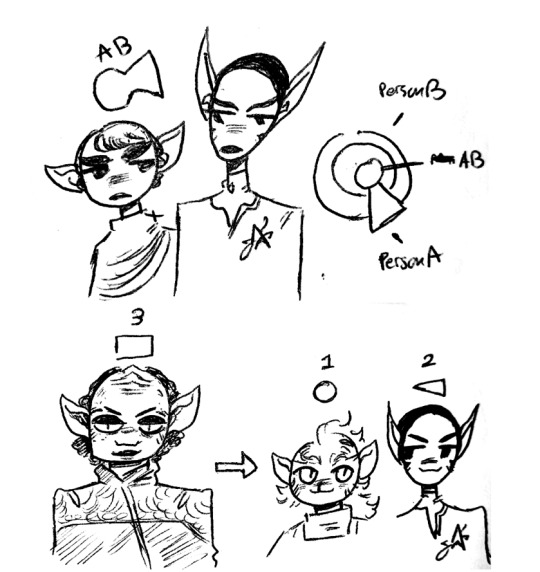
So like, using Tuvok/T'Pel for this since she's his bondmate. When Tuvok has a stable bond with T'Pel they are 'two bodies one mind' but since they are two bodies and do different things all day/have different personalities/upbringings their 'one mind' is constantly being shaped by the two of them. They are distinct beings who are just constantly sharing ideas, thoughts and feelings with one another. They're more of a 'unit' in my mind than a singular person. I used the IDIC symbol to visualize this bc I realized it was sort of similar; two seemingly disparate shapes come together to make something beautiful, but you can still see all the parts that make the whole. Meanwhile Tuvix is a distinct person. Neelix and Tuvok don't communicate while they are joined within him (as evidenced by the fact that they can't be asked their opinion on separating him in the episode. They have essentially 'died' in order to make Tuvix) and Tuvix seems to view them as more his parents. They provide a certain amount of background for him (he remembers their relationships with people) but has his own will and talents separate from them (He appears to be shown as very charismatic which neither Neelix nor Tuvok seem to be in canon, though I personally find them charming). I would characterize Tuvix more of a 'son'. Tuvok and Neelix's experiences are his 'upbringing' but they are no longer there to have opinions on what's happening. He can guess what they would think but as he's a distinct person his thoughts on them are colored by his own personality. (As evidenced by him saying they'd both want him to live which Janeway challenges) I visualized this through numbers. When you see the number '3' you can imagine how it got there...2+1, 4-1, etc but you can't see it. I also wanted to show two people who are not bonded. As you can see Tuvok is a 'whole' person without a bondmate but I imagine he wouldn't feel that way because of how long he's operated as a bonded mind. As he said, "I feel incomplete without them." To me it doesn't seem that being part of Tuvix would be comparable to a bondmate as 'Tuvok' doesn't exist while part of Tuvix. He isn't a 'unit' he's a small and static component of a completely different person. Hypothetically, if Tuvix had been allowed to live he would have probably eventually stopped closely resembling either Neelix or Tuvok as he would have other things and experiences to draw from in regards to who he was. It's sort of the difference between discussing where you want to eat with someone else as opposed to reading online reviews?? You wouldn't really say you came up with a decision together in the latter case.
But I also don't think Tuvok would find it invasive. I think he would find things like his brainwashing by Teero or being assimilated into the borg invasive but the Tuvix situation feels more like he'd think it was 'interesting' or 'mildly disconcerting'. He might vaguely dislike the thought of almost being unfaithful to his wife but also have to just accept that Tuvix wasn't him v_v which I think he could do pretty easily. Maybe Neelix would be more perturbed by it hehe...~
#Q&A#40cleverways#this was a very interesting question and also I love talking about Tuvok and how I see Vulcan bonds#so I REALLY don't know why I didn't ans wer it for like SO long I'm SORRY#It's honestly amazing ppl wanna ask me stuff about things so thank you very much~!!!#I hope this answers your question~!! And hey - this is only my opinion...it's canon gray area!#if ANYTHING I would think him being assimilated into the borg would weirdly and complicatedly be more similar#though still not exactly like it (as borg have no free will) and very invasive/frightening#I think about Seven saying she misses the 'voices' of the collective and how alone she felt without them and I look at Tuvok and I go hmmmm#same hat????????#st voyager
12 notes
·
View notes
Text
I always come back to read this post because it’s well-put and makes a lot of sense, especially if reading what N says about singularities and how they are created.
Dazai had no way of not becoming a singularity. I think between of all the gifted he had no way of escaping that fate and died the minute his ability showed up, and it’s something I been wanting to know for a long time and it’s about abilities: when do they appear? ability users are born with them? how do they even find out about their abilities? I can’t imagine on what case scenario people like Fukuzawa ,who can help his subordinates control their abilities, but how do you manage to discover that? Yosano’s case is on the table too, on what situation do you even find out you can actually save people but they have to be extremely injured to do so? I’m not even going to get started on Kyouka’s mother and the fact that (I’m going to assume only some) abilities can be transferred via objects.
It would be sad if it actually turned to be true because from what it seems ‘Dazai’ is living to the best he can from what he knows and desires to some point (fulfill Oda’s wish and save people) but if he is just an ability it’s kind of heartbreaking because Dazai never got to be someone, and maybe his death wasn’t painful at all, he just died and that’s it, but the fact that an ability can end their user is something else.
And also because it seems like ‘Dazai’s’ and Chuuya’s cases might not be the same. ‘Dazai’ being an ability itself and Chuuya being a clone for a self-controlled singularity, and okay, it sounds like they are the same, but ‘Dazai’ doesn’t even have that sense of humanity of himself, rather visualizing himself as “not longer human” because he’s not one, at least not longer. And Chuuya, for me the biggest difference between the two is that I don’t think there is a more self-contradictory ability such as Dazai’s, an ability who can nullify other abilities, which would case itself to nullify itself, and over and over and over, but Chuuya’s is about gravity manipulation, and this one singularity is on a clone so it doesn’t make this clone, being Chuuya, a singularity (technically) because the singularity is not the user because they were not related to each other from the beginning but put on the other’s way.
I’m not sure if you are able of understanding this last part, but even if they might sound similiar I don’t think they are because one is the ability itself who became a singularity and took over the user’s body, while the other is about the body getting this singularity but not becoming this singularity itself because they are separated. I would say its different being someone who was born vulnerable to illness from someone that grew vulnerable to them.
Oh and also, No Longer Human is an ability itself, if anything what it has it’s Dazai’s personality and appearance, but it’s not a human per se, while Chuuya’s is a self-controlled one and would actually make this clone being able of creating a life because it can self-regulated regardless it’s nature, making Chuuya human in that matter because it’s not this singularity, but it is a part of him.
its five am give me a break
BSD Theory: What is Dazai?
With the release of Storm Bringer, Asagiri has given us a lot more insight into the nature of abilities, their limits, how they interact with one another, and the creation of singularities. And although Dazai wasn’t the main focus of the story, it may have revealed a lot more about him than it would seem at first glance. More specifically: that the name of his ability, “No Longer Human”, may be a lot more literal than we previously thought.
Spoilers for Storm Bringer, 55 Minutes, and Dead Apple under the cut
Keep reading
947 notes
·
View notes
Text
Caddo Lake Review: Shyamalan Meets Folklore in a Time-Bending Mystery

It’s not every day you walk into a film expecting a slow-burn thriller about a missing person, only to be slapped in the face by portals, time loops, and a gator that has seen better days. But here we are, diving into the weirdly fascinating world of Caddo Lake, a film that feels like an eerie mashup of Southern folklore and M. Night Shyamalan-style twists. Directed by Celine Hand and Logan George and produced by M. Night Shyamalan, this film has a lot going on, and while it can be confusing at times, it’s also the kind of movie that lingers with you. https://youtu.be/Rrx_lZxzjbQ The Story: A Haunting Beginning Caddo Lake opens with a chilling sequence—imagine an ordinary day turning into a nightmare when a car crashes into the lake, and the bodies of a married couple that are found submerged. That’s how you start a thriller. Right off the bat, you know this movie is not messing around, and the tension never really lets up. The tragedy sets the tone for everything that follows, which makes sense since water and death are pretty much a running theme here. It’s the kind of cold open that grabs you by the anxiety and doesn’t let go. As we follow the lives of the families connected to the lake, you can feel that something’s off. The atmosphere is creepy, and there’s a slow build-up as you realize there’s something supernatural about this place. Oh, and did I mention the alligator? Even though it’s dead, the way the girl handles it by the head will make you rethink your stance on swamp life. Why is this movie on one from the beginning? Time Loops, Portals, and Confusion Okay, here’s where things get a little wild. The movie toys with time—literally. Portals appear, people walk through them, and suddenly we’re in different timelines. Ellie, (Eliza Scanlen), finds herself in one of these portals, and her life takes a bizarre turn. Meanwhile, Paris (our other main character played by Dylan O'Brien) has his own storyline going on, and it starts to feel like two separate movies happening simultaneously. But then, you realize they’re connected. Sort of. Maybe. The film doesn’t spell things out for you, and that’s both its strength and weakness. There are wolves in the swamp—yes, wolves. And that’s just one of the many surreal elements that pop up, hinting at folklore tied to the lake. It’s like you’re constantly being pulled into a puzzle, but one that never quite gives you all the pieces. Why are there wolves? Who cut the gator? And what’s with the portals? Shyamalan Vibes Without the Payoff Look, we all know M. Night Shyamalan loves a good twist, and Caddo Lake delivers some of that Shyamalan-esque mystery. But while the movie dangles multiple threads—missing girls, time loops, ancient folklore—it doesn’t fully tie them together in an easy-to-follow way. The third act especially feels like it’s trying to wrap up too many loose ends at once, and instead of providing clarity, it just leaves you scratching your head. The acting, especially from Paris and Ellie, holds the film together, but I wish we had more from the supporting characters. Shout out to the lone Black guy who exists solely in the background—because we always love some diversity that doesn’t actually matter to the plot (insert eye-roll). Visuals and Atmosphere: Dark and Unsettling One thing Caddo Lake does incredibly well is its atmosphere. The cinematography captures the murkiness of the lake and the dense, fog-filled surroundings in a way that keeps you on edge. There’s a constant feeling of dread, like something’s lurking just out of sight. It’s beautifully unsettling, and while the plot may not always hit the mark, the visuals sure do. Also, can we talk about the sound design? From the eerie silence that follows each portal jump to the creepy noises in the swamp, the film uses sound to enhance the horror element. It’s like you’re waiting for something terrifying to jump out, but instead, you get a slow, creeping dread. Conclusion: Worth the Watch? So, is Caddo Lake worth your time? If you’re into slow-burn mysteries with a dash of folklore and a lot of “what just happened” moments, then absolutely. But if you’re looking for a clean, straightforward narrative, you might want to skip this one. The movie takes risks, and while not all of them pay off, it’s refreshing to see a thriller that doesn’t rely on cheap scares. Caddo Lake may not be for everyone, but it’s definitely a conversation starter. It’s the kind of film you’ll want to discuss afterward, trying to figure out how all the pieces fit—or if they even fit at all. It’s messy, confusing, and at times brilliant. Just be ready to walk out of the theater with more questions than answers. Read the full article
0 notes
Text
Post29—forefront
When people talk about video games, they always talk about character design, animation effects and visual effects, which also reflects the importance of good animators for game development. Games are also a very important part of my life. A good game can not only provide good emotional value for me but also relieve stress. Its art style and art animation are also very noteworthy. Even though three-dimensional games occupy the mainstream of the game market in today's society, two-dimensional game style is still very popular. On the well-known game platform "Steam", people can search for two-dimensional games of many games, which have not only sold tens of thousands of copies but also received high praise from players. Different kinds of video games have appeared in people's vision, and today in this blog I will introduce a game that I personally like very much. Among these games "Rusty Lake" is a puzzle game from the game studio of the same name "Rusty Lake" in Amherstedam, the Netherlands. The game is a series, each work tells a story, but each game has a certain connection between the storyline and the network of characters. The world view of the game as a whole and the mysterious and dark, alchemy, human sacrifice, reincarnation and other concepts are often present elements, and the game uses complex plot, abnormal decryption methods, surreal art style and so on to make this game completely different from other puzzle games. This game has attracted a lot of attention with its bizarre plot and special artistic style. For example, "Rusty Lake Hotel" is one of the works, which tells the story of five guests invited to the Rusty Lake Hotel, and players kill all of them according to the storyline, get their bodies and make the next dish. This dark and bloody story makes people feel both scared and have the urge to explore. The character design in this game is also very special, the characters are animal heads plus human bodies, making the whole game look more bizarre. I would like to emphasize that this game uses two-dimensional animation to present the game picture and a simple and strange artistic style. This flat and minimalist artistic style is not common in games, but the author uses excellent plot to make this painting style perfectly match the game. This artistic style is also the style that I have been pursuing and trying. This form of creation makes the game work separate from the countless game works and shows the artist's artistic style well. It was also the first time I saw the art of surrealism incorporated into a game. As a dedicated video game player, working in a game studio and developing your own art style would be a great choice.
All in all, the Rusty Lake series has won a lot of praise for its excellent story, weird and special art style, and I expect more from the author.


Pinterest. (2024). Pin on anime. [online] Available at: https://www.pinterest.co.uk/pin/14073817578222523/ [Accessed 21 Aug. 2024].
0 notes
Text
Godzilla x Kong: The New Empire (2024)

I didn't expect Godzilla x Kong: The New Empire to make me seriously consider the topic of film reviews, but here we are. I'm in the camp that's going to call this a good movie. The film has some clearly established objectives and it meets them. It's sure to please those who buy tickets to see it whether they're established fans of the Godzilla franchise or were introduced to the King of the Monsters with this MonsterVerse cinematic series. On the big screen, where the action is "to scale", it's a lot of fun and moves quickly from one earth-shattering brawl to the next. It's going to make a lot of people happy, so how can make it "bad"? On the other hand, the screenplay is often clumsy and those clearly established objectives mean the film is unambitious. All it wants to do is what you'd expect it to and nothing more.
Set a few years after the events of the previous film, Titan attacks are now a way of life, even if the colossal beasts are inevitably repelled by Godzilla. Meanwhile, Kong discovers he is not the only member of his species living in Hollow Earth and Dr. Ilene Andrews (Rebecca Hall), self-described titan expert/conspiracy theorist Bernie Hayes (Brian Tyree Henry), Titan veterinarian "Trapper" (Dan Stevens) and young Jia (Kaylee Hottle) travel underground to investigate.
The last time Adam Wingard directed Godzilla and Kong, we had two separate human plots, one of which could've been eliminated without affecting the plot too much. Consequently, writers Terry Rossio, Simon Barrett and Jeremy Slater now give us the minimum amount of humans on screen. We don't even have random loved ones on the surface to put in danger when a monster shows up. Aside from the Kong/Godzilla storyline (I'll get to it in a bit), all the people traveling to the Hollow Earth worry about is how Kong will defeat the monster he has to square off against, except for Jia and Dr. Ilene, who have a more involved, more emotional story independent from the great ape's. There's a thin point made about exploiting the environment and the impact our civilization might have on the residents of Hollow Earth, but it's blink and you miss it. That's what I mean when I say this film is unambitious. The movie everyone is going to compare GxK: TNE is Godzilla Minus One, which said a lot about a lot of things, had characters the audience fell in love with and delivered great monster action. To be fair, this is not that film. It doesn't want to be - but it could've been.
Now, let's get into the Kong/Godzilla story so I can give the film some praise. Neither of these characters can speak, which means a lot of the storytelling is done solely via body language and actions. While the motivations may be simplistic, what's happening and how we should react is always clear. We even manage to get a pretty good "feel" for the personalities of the more prominently featured kaiju (there are even more here than in the first two hours of Godzilla: King of the Monsters), which is not an easy task. For established fans, it's a treat to see several new monsters introduced, instead of getting old favorites with new paint jobs… again. I'm also going to circle back to Jia, who had a similar story to Kong's in the previous movie and does here too. There's a nice parallel and I sense that this universe has finally established some characters it can bring back over and over again. They will ensure that we care about more than just Kong and Godzilla. I'm particularly happy with the Titan veterinarian, who would naturally run toward the series' action and for good reason.
Like its predecessor, Godzilla x Kong offers several big, varied action scenes in all sorts of different environments. You may not remember the dialogue but you will remember the visuals. It also shows audiences something new, whether they're intimately familiar with the Godzilla franchise or not, which is another thing easier said than done considering it's appeared in 38 films so far. All of this makes me hate that reviews have to put movies in buckets of "good" and "bad". It could've been a better movie. It should've been a better movie but I also like what we got and I won't be the only one. (Theatrical version on the big screen, March 28, 2024)
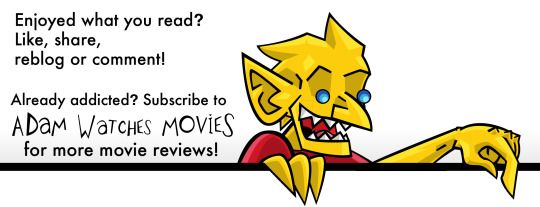
#Godzilla x Kong: The New Empire#Godzilla vs. Kong#Godzilla#Kong#King Kong#Adam Wingard#Terry Rossio#Simon Barrett#Jerey Slater#Rebecca Hall#Brian Tyree Henry#Dan Stevens#Kaylee Hottle#Alex Ferns#Fala Chen#2024 movies#2024 films
1 note
·
View note
Text
I can see this being the case! Though... if it is, then that makes his creation/programming even more disturbing.
See like, to me, what he experiences can be divided into two separate things that don't necessarily have to accompany one another. They do in us, and in other similar animals, but they don't have to if one was creating a living thing and wanted to separate them.
There's the detection and identification of noxious stimuli, and then there's suffering, AKA pain.
You can have the former without the latter, and I feel like the former is absolutely vital for a standalone, self-sufficient war machine. Cuff would need to know if he was being damaged in any way. He'd need to know if he was getting smacked, or melted, or frozen, or electrified, or whatever.
This is especially true because he appears to fight alone: as far as I can tell, when he last attacked Athia by way of Visoria, no one was with him. There's no one to look him over after a fight, for example, and identify any damage done to his body. There's no one to tell him how many little birds have been vaporized. There's certainly no one there to repair him.
So he needs to know if he's being damaged, both during a fight and after. Otherwise, I doubt he'd last long. People who are unable to tell if their bodies are being damaged (individuals, say, with mutations that don't allow for the sensation of noxious or heat stimuli) tend to not do well unless compensatory measures are taken. And I doubt Rheddah would want its weapon to fail because said weapon couldn't tell when it was getting beat up.
So yeah: the ability to sense noxious stimuli is something I'd think would be vital for Cuff to have... but pain? The actual ability to suffer from those stimuli? That, I'd agree, is superfluous for a weapon. Problematic, even, as it could distract from desired action and result in potential failure.
Pain, in the sense of suffering, is at least partially psychosomatic for all of us. It's why some people and animals have very high pain tolerances while others do not. It's what makes the experience of pain unique to the individual. Generally speaking, everyone senses the noxious stimuli, but not everyone experiences them the same way. Everyone's pain experience is different.
And that begs the question: why give Cuff a pain experience at all? Why make a weapon that can suffer, rather than just take an unfeeling self-inventory and act accordingly? Because I do think he suffers in some of these dialogues; he's not just cataloging damage and reacting, he's legitimately hurting.
It seems like an odd thing to do, to make a weapon that can hurt like a person can. And the reason for it is anyone's guess. We know he's at least partially composed of human souls; that may be a factor. Perhaps it's as y'all headcanon, and there was a human that was used as a foundation for Cuff's creation. Perhaps the Rheddig and that unnamed higher power are just weirdo sadists; who knows!
All that said, I suppose I interpret it as a mix. The actual experience of suffering forms in the mind, but I feel like the extent of it would be informed by some sort of sense-based understanding of how much damage has been done, beyond visual assessment. Which... I guess is sort of how it works for us organics, isn't it?
I just wonder why Cuff seems able to go that extra emotional step. Why in the world would anyone make a weapon that can suffer?
happy monday today is going to suck
“What’s the matter, little Tanta?” he drawled. “Isn’t this what you wanted?”
As soon as she could breathe again, Frey shoved to her feet and rushed him, banking on having the element of surprise. It was a poor bet. Susurrus, with all the ease of a cat playing with its dinner, batted her aside. She felt a rib crack on impact; by the hiss he made under his breath, he had felt it too.
28 notes
·
View notes
Link
“Elliot Page doesn’t remember exactly how long he had been asking.
But he does remember the acute feeling of triumph when, around age 9, he was finally allowed to cut his hair short. “I felt like a boy,” Page says. “I wanted to be a boy. I would ask my mom if I could be someday.” Growing up in Halifax, Nova Scotia, Page visualized himself as a boy in imaginary games, freed from the discomfort of how other people saw him: as a girl. After the haircut, strangers finally started perceiving him the way he saw himself, and it felt both right and exciting.
The joy was short-lived. Months later, Page got his first break, landing a part as a daughter in a Canadian mining family in the TV movie Pit Pony. He wore a wig for the film, and when Pit Pony became a TV show, he grew his hair out again. “I became a professional actor at the age of 10,” Page says. And pursuing that passion came with a difficult compromise. “Of course I had to look a certain way.”
We are speaking in late February. It is the first interview Page, 34, has given since disclosing in December that he is transgender, in a heartfelt letter posted to Instagram, and he is crying before I have even uttered a question. “Sorry, I’m going to be emotional, but that’s cool, right?” he says, smiling through his tears.
It’s hard for him to talk about the days that led up to that disclosure. When I ask how he was feeling, he looks away, his neck exposed by a new short haircut. After a pause, he presses his hand to his heart and closes his eyes. “This feeling of true excitement and deep gratitude to have made it to this point in my life,” he says, “mixed with a lot of fear and anxiety.”
It’s not hard to understand why a trans person would be dealing with conflicting feelings in this moment. Increased social acceptance has led to more young people describing themselves as trans—1.8% of Gen Z compared with 0.2% of boomers, according to a recent Gallup poll—yet this has fueled conservatives who are stoking fears about a “transgender craze.” President Joe Biden has restored the right of transgender military members to serve openly, and in Hollywood, trans people have never had more meaningful time onscreen. Meanwhile, J.K. Rowling is leveraging her cultural capital to oppose transgender equality in the name of feminism, and lawmakers are arguing in the halls of Congress over the validity of gender identities. “Sex has become a political football in the culture wars,” says Chase Strangio, deputy director for transgender justice at the ACLU.

(Full article with photos continued under the “read more”)
And so Page—who charmed America as a precocious pregnant teenager in Juno, constructed dreamscapes in Inception and now stars in Netflix’s hit superhero show The Umbrella Academy, the third season of which he’s filming in Toronto—expected that his news would be met with both applause and vitriol. “What I was anticipating was a lot of support and love and a massive amount of hatred and transphobia,” says Page. “That’s essentially what happened.” What he did not anticipate was just how big this story would be. Page’s announcement, which made him one of the most famous out trans people in the world, started trending on Twitter in more than 20 countries. He gained more than 400,000 new followers on Instagram on that day alone. Thousands of articles were published. Likes and shares reached the millions. Right-wing podcasters readied their rhetoric about “women in men’s locker rooms.” Casting directors reached out to Page’s manager saying it would be an honor to cast Page in their next big movie.
So, it was a lot. Over the course of two conversations, Page will say that understanding himself in all the specifics remains a work in progress. Fathoming one’s gender, an identity innate and performed, personal and social, fixed and evolving, is complicated enough without being under a spotlight that never seems to turn off. But having arrived at a critical juncture, Page feels a deep sense of responsibility to share his truth. “Extremely influential people are spreading these myths and damaging rhetoric—every day you’re seeing our existence debated,” Page says. “Transgender people are so very real.”
That role in Pit Pony led to other productions and eventually, when Page was 16, to a film called Mouth to Mouth. Playing a young anarchist, Page had a chance to cut his hair again. This time, he shaved it off completely. The kids at his high school teased him, but in photos he has posted from that time on social media he looks at ease. Page’s head was still shaved when he mailed in an audition tape for the 2005 thriller Hard Candy. The people in charge of casting asked him to audition again in a wig. Soon, the hair was back.
Page’s tour de force performance in Hard Candy led, two years later, to Juno, a low-budget indie film that brought Page Oscar, BAFTA and Golden Globe nominations and sudden megafame. The actor, then 21, struggled with the stresses of that ascension. The endless primping, red carpets and magazine spreads were all agonizing reminders of the disconnect between how the world saw Page and who he knew himself to be. “I just never recognized myself,” Page says. “For a long time I could not even look at a photo of myself.” It was difficult to watch the movies too, especially ones in which he played more feminine roles.
Page loved making movies, but he also felt alienated by Hollywood and its standards. Alia Shawkat, a close friend and co-star in 2009’s Whip It,describes all the attention from Juno as scarring. “He had a really hard time with the press and expectations,” Shawkat says. “‘Put this on! And look this way! And this is sexy!’”
By the time he appeared in blockbusters like X-Men: The Last Stand and Inception, Page was suffering from depression, anxiety and panic attacks. He didn’t know, he says, “how to explain to people that even though [I was] an actor, just putting on a T-shirt cut for a woman would make me so unwell.” Shawkat recalls Page’s struggles with clothes. “I’d be like, ‘Hey, look at all these nice outfits you’re getting,’ and he would say, ‘It’s not me. It feels like a costume,’” she says. Page tried to convince himself that he was fine, that someone who was fortunate enough to have made it shouldn’t have complaints. But he felt exhausted by the work required to “just exist,” and thought more than once about quitting acting.
In 2014, Page came out as gay, despite feeling for years that “being out was impossible” given his career. (Gender identity and sexual orientation are, of course, distinct, but one queer identity can coexist with another.) In an emotional speech at a Human Rights Campaign conference, Page talked about being part of an industry “that places crushing standards” on actors and viewers alike. “There are pervasive stereotypes about masculinity and femininity that define how we’re all supposed to act, dress and speak,” Page went on. “And they serve no one.”
The actor started wearing suits on the red carpet. He found love, marrying choreographer Emma Portner in 2018. He asserted more agency in his career, producing his own films with LGBTQ leads like Freeheld and My Days of Mercy. And he made a masculine wardrobe a condition of taking roles. Yet the daily discord was becoming unbearable. “The difference in how I felt before coming out as gay to after was massive,” says Page. “But did the discomfort in my body ever go away? No, no, no, no.”
In part, it was the isolation forced by the pandemic that brought to a head Page’s wrestling with gender. (Page and Portner separated last summer, and the two divorced in early 2021. “We’ve remained close friends,” Page says.) “I had a lot of time on my own to really focus on things that I think, in so many ways, unconsciously, I was avoiding,” he says. He was inspired by trailblazing trans icons like Janet Mock and Laverne Cox, who found success in Hollywood while living authentically. Trans writers helped him understand his feelings; Page saw himself reflected in P. Carl’s memoir Becoming a Man. Eventually “shame and discomfort” gave way to revelation. “I was finally able to embrace being transgender,” Page says, “and letting myself fully become who I am.”
This led to a series of decisions. One was asking the world to call him by a different name, Elliot, which he says he’s always liked. Page has a tattoo that says E.P. PHONE HOME, a reference to a movie about a young boy with that name. “I loved E.T. when I was a kid and always wanted to look like the boys in the movies, right?” he says. The other decision was to use different pronouns—for the record, both he/him and they/them are fine. (When I ask if he has a preference on pronouns for the purposes of this story, Page says, “He/him is great.”)
A day before we first speak, Page will talk to his mom about this interview and she will tell him, “I’m just so proud of my son.” He grows emotional relating this and tries to explain that his mom, the daughter of a minister, who was born in the 1950s, was always trying to do what she thought was best for her child, even if that meant encouraging young Page to act like a girl. “She wants me to be who I am and supports me fully,” Page says. “It is a testament to how people really change.”
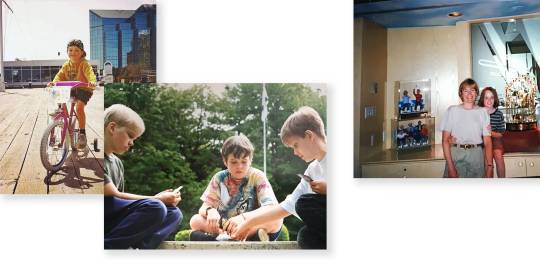
Another decision was to get top surgery. Page volunteers this information early in our conversation; at the time he posted his disclosure on Instagram, he was recovering in Toronto. Like many trans people, Page emphasizes being trans isn’t all about surgery. For some people, it’s unnecessary. For others, it’s unaffordable. For the wider world, the media’s focus on it has sensationalized transgender bodies, inviting invasive and inappropriate questions. But Page describes surgery as something that, for him, has made it possible to finally recognize himself when he looks in the mirror, providing catharsis he’s been waiting for since the “total hell” of puberty. “It has completely transformed my life,” he says. So much of his energy was spent on being uncomfortable in his body, he says. Now he has that energy back.
For the transgender community at large, visibility does not automatically lead to acceptance. Around the globe, transgender people deal disproportionately with violence and discrimination. Anti-trans hate crimes are on the rise in the U.K. along with increasingly transphobic rhetoric in newspapers and tabloids. In the U.S., in addition to the perennial challenges trans people face with issues like poverty and homelessness, a flurry of bills in state legislatures would make it a crime to provide transition-related medical care to trans youth. And crass old jokes are still in circulation. When Biden lifted the ban on open service for transgender troops, Saturday Night Live’s Michael Che did a bit on Weekend Update about the policy being called “don’t ask, don’t tuck.”
Page says coming out as trans was “selfish” on one level: “It’s for me. I want to live and be who I am.” But he also felt a moral imperative to do so, given the times. Human identity is complicated and mysterious, but politics insists on fitting everything into boxes. In today’s culture wars, simplistic beliefs about gender—e.g., chromosomes = destiny—are so widespread and so deep-seated that many people who hold those beliefs don’t feel compelled to consider whether they might be incomplete or prejudiced. On Feb. 24, after a passionate debate on legislation that would ban discrimination against LGBTQ people, Representative Marie Newman, an Illinois Democrat, proudly displayed the pride flag in support of her daughter, who is trans. Representative Marjorie Taylor Greene, a Georgia Republican, responded by hanging a poster outside her office that read: There are TWO genders: MALE & FEMALE.
The next day Dr. Rachel Levine, who stands to become the first openly transgender federal official confirmed by the Senate, endured a tirade from Senator Rand Paul about “genital mutilation” during her confirmation hearing. My second conversation with Page happens shortly after this. He brings it up almost immediately, and seems both heartbroken and determined. He wants to emphasize that top surgery, for him, was “not only life-changing but lifesaving.” He implores people to educate themselves about trans lives, to learn how crucial medical care can be, to understand that lack of access to it is one of the many reasons that an estimated 41% of transgender people have attempted suicide, according to one survey.
Page has been in the political trenches for a while, having leaned into progressive activism after coming out as queer in 2014. For two seasons, he and best friend Ian Daniel filmed Gaycation, a Viceland series that explored LGBTQ culture around the world and, at one point, showed Page grilling Senator Ted Cruz at the Iowa State Fair about discrimination against queer people. In 2019, Page made a documentary called There’s Something in the Water, which explores environmental hardships experienced by communities of color in Nova Scotia, with $350,000 of his own money. That activism extends to his own industry: in 2017, he published a Facebook post that, among other things, accused director Brett Ratner of forcibly outing him as gay on the set of an X-Men movie. (A representative for Ratner did not respond to a request for comment.)
As a trans person who is white, wealthy and famous, Page has a unique kind of privilege, and with it an opportunity to advocate for those with less. According to the U.S. Trans Survey, a large-scale report from 2015, transgender people of color are more likely to experience unemployment, harassment by police and refusals of medical care. Nearly half of all Black respondents reported being denied equal treatment, verbally harassed and/or physically attacked in the past year. Trans people as a group fare much worse on such stats than the general population. “My privilege has allowed me to have resources to get through and to be where I am today,” Page says, “and of course I want to use that privilege and platform to help in the ways I can.”
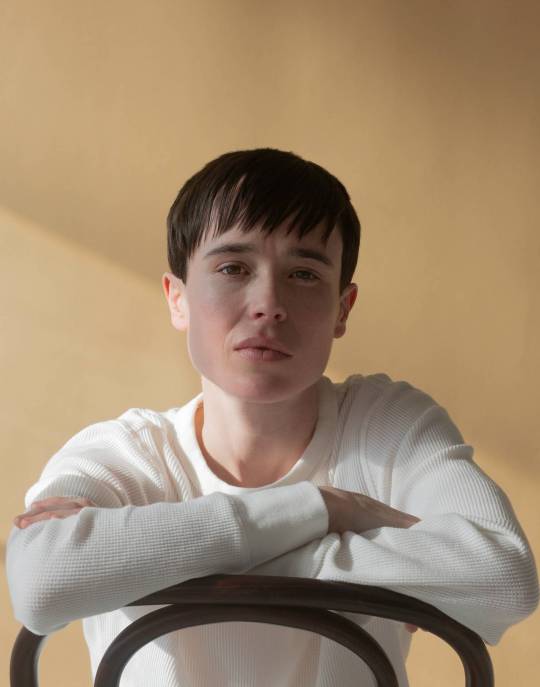
Since his disclosure, Page has been mostly quiet on social media. One exception has been to tweet on behalf of the ACLU, which is in the midst of fighting anti-trans bills and laws around the country, including those that ban transgender girls and women from participating in sports. Mississippi Governor Tate Reeves says he will sign such a bill in the name of “protect[ing] young girls.” Page played competitive soccer and vividly recalls the agony of being told he would have to play on the girls’ team once he aged out of mixed-gender squads. After an appeal, Page was allowed to play with the boys for an additional year. Today, several bills list genitalia as a requirement for deciding who plays on which team. “I would have been in that position as a kid,” Page says. “It’s horrific.”
All this advocacy is unlikely to make life easier. “You can’t enter into certain spaces as a public trans person,” says the ACLU’s Strangio, “without being prepared to spend some percentage of your life being threatened and harassed.” Yet, while he seems overwhelmed at times, Page is also eager. Many of the political attacks on trans people—whether it is a mandate that bathroom use be determined by birth sex, a blanket ban on medical interventions for trans kids or the suggestion that trans men are simply wayward women beguiled by male privilege—carry the same subtext: that trans people are mistaken about who they are. “We know who we are,” Page says. “People cling to these firm ideas [about gender] because it makes people feel safe. But if we could just celebrate all the wonderful complexities of people, the world would be such a better place.”
Even if Page weren’t vocal, his public presence would communicate something powerful. That is in part because of what Paisley Currah, a professor of political science at Brooklyn College, calls “visibility gaps.” Historically, trans women have been more visible, in culture and in Hollywood, than trans men. There are many explanations: Our culture is obsessed with femininity. Men’s bodies are less policed and scrutinized. Patriarchal people tend to get more emotional about who is considered to be in the same category as their daughters. “And a lot of trans men don’t stand out as trans,” says Currah, who is a trans man himself. “I think we’ve taken up less of the public’s attention because masculinity is sort of the norm.”
During our interviews, Page will repeatedly refer to himself as a “transgender guy.” He also calls himself nonbinary and queer, but for him, transmasculinity is at the center of the conversation right now. “It’s a complicated journey,” he says, “and an ongoing process.”
While the visibility gap means that trans men have been spared some of the hate endured by trans women, it has also meant that people like Page have had fewer models. “There were no examples,” Page says of growing up in Halifax in the 1990s. There are many queer people who have felt “that how they feel deep inside isn’t a real thing because they never saw it reflected back to them,” says Tiq Milan, an activist, author and transgender man. Page offers a reflection: “They can see that and say, ‘You know what, that’s who I am too,’” Milan says. When there aren’t examples, he says, “people make monsters of us.”
For decades, that was something Hollywood did. As detailed in the 2020 Netflix documentary Disclosure, transgender people have been portrayed onscreen as villainous and deceitful, tragic subplots or the butt of jokes. In a sign of just how far the industry has come—spurred on by productions like Pose and trailblazers like Mock—Netflix offered to change the credits on The Umbrella Academy the same day that its star posted his statement on social media. Now when an episode ends, the first words viewers see are “Elliot Page.”
Today, there are many out trans and nonbinary actors, directors and producers. Storylines involving trans people are more common, more respectful. Sometimes that aspect of identity is even incidental, rather than the crux of a morality tale. And yet Hollywood can still seem a frightening place for LGBTQ people to come out. “It’s an industry that says, ‘Don’t do that,’” says director Silas Howard, who got his break on Amazon’s show Transparent, which made efforts to hire transgender crew members. “I wouldn’t have been hired if they didn’t have a trans initiative,” Howard says. “I’m always aware of that.”
So what will it mean for Page’s career? While Page has appeared in many projects, he also faced challenges landing female leads because he didn’t fit Hollywood’s narrow mold. Since Page’s Instagram post, his team is seeing more activity than they have in years. Many of the offers coming in—to direct, to produce, to act—are trans-related, but there are also some “dude roles.”
Downtime in quarantine helped Page accept his gender identity. “I was finally able to embrace being transgender,” he says.

Page was attracted to the role of Vanya in The Umbrella Academy because—in the first season, released in 2019—Vanya is crushed by self-loathing, believing herself to be the only ordinary sibling in an extraordinary family. The character can barely summon the courage to move through the world. “I related to how much Vanya was closed off,” Page says. Now on set filming the third season, co-workers have seen a change in the actor. “It seems like there’s a tremendous weight off his shoulders, a feeling of comfort,” says showrunner Steve Blackman. “There’s a lightness, a lot more smiling.” For Page, returning to set has been validating, if awkward at times. Yes, people accidentally use the wrong pronouns—“It’s going to be an adjustment,” Page says—but co-workers also see and acknowledge him.
The debate over whether cisgender people, who have repeatedly collected awards for playing trans characters, should continue to do so has largely been settled. However, trans actors have rarely been considered for cisgender parts. Whatever challenges might lie ahead, Page seems exuberant about playing a new spectrum of roles. “I’m really excited to act, now that I’m fully who I am, in this body,” Page says. “No matter the challenges and difficult moments of this, nothing amounts to getting to feel how I feel now.”
This includes having short hair again. During our interview, Page keeps rearranging strands on his forehead. It took a long time for him to return to the barber’s chair and ask to cut it short, but he got there. And how did that haircut feel?
Page tears up again, then smiles. “I just could not have enjoyed it more,” he says.”
#suicide m#transphobia m#Elliot Page#transgender#representation#celebrities#actors#tv#movies#rep#trans#transmasculine#nonbinary#queer#long post
2K notes
·
View notes
Text
Jack Vessalius as a Symbol for Depression
Ever since I first read PandoraHearts, I have interpreted Jack Vessalius as at least a partial symbolic representation of depression, especially in his relationship with Oz.
(Skip to “keep reading” to go straight to the analysis; this beginning portion is little more than a disclaimer.)
Jack is a complex, fascinating character, and it is precisely due to this that I believe any number of interpretations regarding him contain merit. Whether you view Jack as an abuser, a manifestation of mental illness, or an extraordinarily-written character that does not require a figurative understanding to be interesting, I think this is valid.
I am saying this first and foremost because I want to be clear: this is not a persuasive essay. I am not trying to change anybody’s minds about liking or disliking Jack Vessalius, nor am I trying to devalue any other interpretations of this extremely nuanced character. Some points may be a bit vague and connections disjointed, though I attempted to minimize this. Any discussion of mental illness and abuse is based on either my personal experiences or those of people I know. I do not intend to offend anybody.
This post is simply the product of years of disorganized yet in-depth thoughts about this concept. I hope some of you will be interested.
Major spoilers for the entire manga below the cut. Manga panels are from the Fallen Syndicate fan translation. This...is going to get very long.
Emotional Abuse
Jack exists within Oz’s mind. When these two interact, it almost always occurs within Oz’s head, providing every conversation with an inherently emotional and symbolic element.
Jack initially appears to Oz as an unknown but crucial figure. Whether he is trustworthy or even harmful remains to be seen, but his input is necessary. He is the only insight Oz has into his lost memories; he knows something Oz does not. Oz is suffering an identity crisis, realizing he has endured something he does not completely understand, something that could potentially change his entire life once he does understand it. And yet, this mysterious voice within his head understands it.
This desperation makes it almost irrelevant whether Jack is credible, whether his advice is well-intentioned. Normally a rather cynical and distrusting young man, Oz follows Jack from the beginning despite wanting answers. He does indeed receive answers, but they are perhaps not quite what he bargained for, in more ways than one.
Once Jack’s true nature is revealed, the extent to which he has used Oz’s memories and emotions against him becomes apparent. Jack does present Oz with new insights into his experiences, but he only ever provides Oz with enough information to convince him to act a certain way. He never willingly gives a fair, all-encompassing portrayal of an event from Oz’s past. He manipulates Oz’s perceptions of his memories to fit a particular emotional narrative, one that is inevitably perplexing and demeaning to Oz.
This bears a resemblance to the way depression warps how we view past events. When we look back at our experiences, we don’t see the entire picture--though we are convinced that we may. We see a skewed version of an incident that actually occurred. Perhaps this incident proves little to nothing about ourselves in reality, but viewed through the lens of depression, everything about it seems to scream that we are useless. And it is nearly impossible to try and perceive these events any differently, because when depression overtakes our minds, this perspective appears to be the only one through which it is possible to examine any of our pasts.
By the time Jack’s intentions have been exposed, he is also explicitly emotionally abusive towards Oz. It is easy to recognize Jack’s statements as not only psychologically damaging, but disturbingly similar to what we hear in our own heads when suffering depression. Think about these assertions without the very literal plot elements that support them: Jack declares Oz less than human, insists that nobody loves him, and claims that he has no future because the only thing he’s good for is hurting those around him. He convinces Oz that he is useless, hopeless, and worthless.
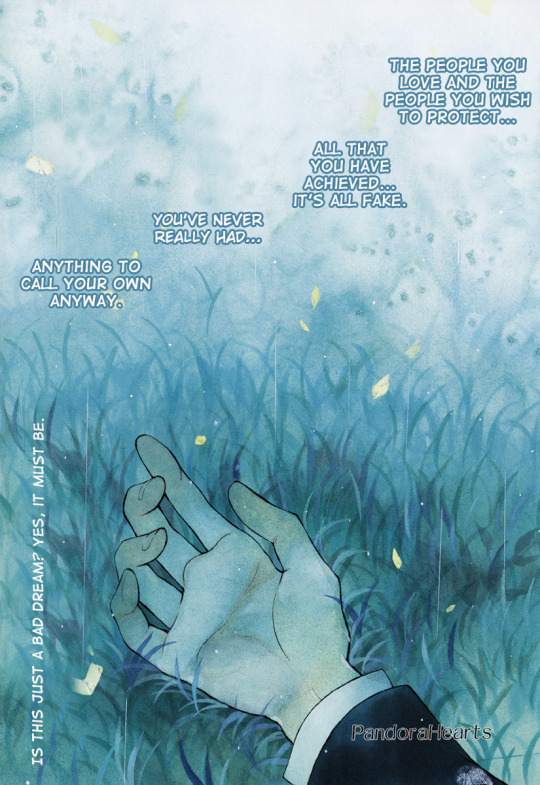
Jack drills these ideas into Oz’s head when he is at his most vulnerable. This is when Oz breaks down and becomes convinced that all of Jack’s statements are true. He is not who he thought he was; he never has been, and so his life is meaningless.
This is arguably when Oz reaches his all-time emotional low. While it was already addressed that he had been struggling intensely with his mental health and was probably suicidal, up to this point, he always retained some level of self-preservation (however slight). Now, he silently accepts that the world would be better off without him and offers no physical or emotional resistance to his own execution. Jack’s words worm their way into his heart and corrupt his self-image to the point where his only reaction to Oswald’s sword swinging towards him is a blank, unflinching stare.

Trauma Response
It’s not uncommon for Jack to manifest during catastrophic moments--that is, whenever a situation triggers (or comes close to triggering) overwhelming memories of Oz’s trauma. When Oz is losing control over his emotional and physical faculties, Jack often encourages him to make the trigger disappear using the quickest and easiest method available. Unsurprisingly, this method generally takes advantage of Oz’s extraordinary powers. In other words, the “tactic” Jack advises Oz to use is simply mindless destruction.
In the second half of the manga, Oz is at his least emotionally stable. It is not a coincidence that this is also the point during which Jack gains the ability to completely hijack Oz’s body. This development allows Jack to commit impulsive acts of aggression through Oz, while Oz himself retains little to no control.
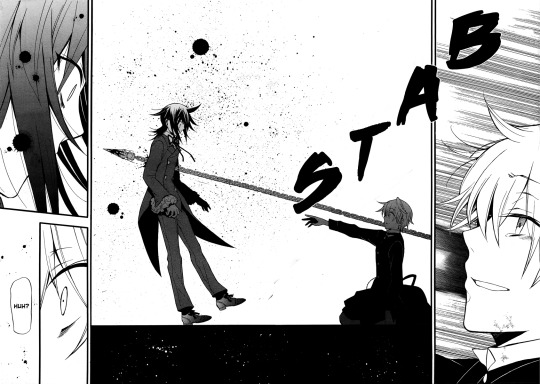
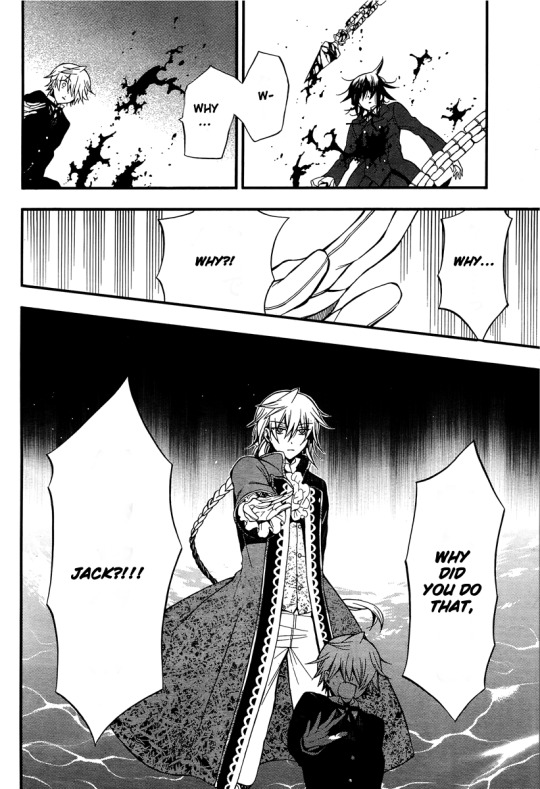
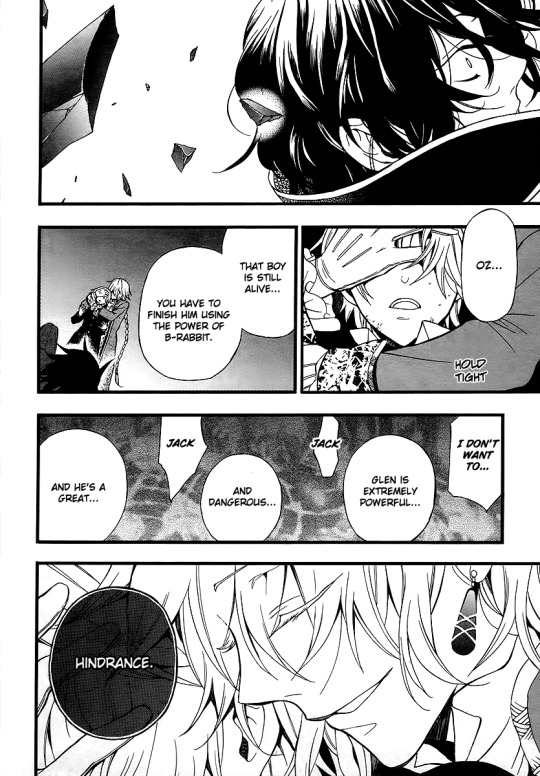
Jack overwhelms Oz with unnecessary flashbacks to traumatic events and makes an excess of harmful connections between past and present circumstances. Oz’s panicked, distressed responses to this are tools he uses to further coax Oz into acting in a self-destructive manner. These tendencies may not only connect Jack to the concept of depression, but the concept of post-traumatic stress disorder as well.
Identity Crisis
Although Jack is introduced extremely early in the manga, one of the story’s main mysteries is the exact nature of his connection to Oz. This relationship shifts several times, especially with regards to who is “in control” and who is the true “owner” of the physical body.
Once it becomes public knowledge that Jack is “within” Oz, the identity of the former overcomes the identity of the latter in the eyes of the general populace. Figures who never before gave Oz a second glance begin to pay incredibly close attention to him; many directly address him through his connection to Jack rather than as a separate entity.
Oz is deeply troubled by the way others ignore him in favor of an aspect of his identity that he feels does not truly represent him--an aspect of his identity that is at least partially out of his control. However, he is also relatively resigned to being judged in this manner. He lacks knowledge of how to change this circumstance because even he does not truly understand the extent to which he and Jack are connected.
It is true that at this point in the story, Jack is practically worshipped. His destructive actions and devastatingly selfish nature have not yet been exposed. Because of this, Oz as Jack’s “vessel” is typically viewed through a positive lens. Still, this situation reflects how people with depression are sometimes reduced to nothing more than a mental illness by their peers. Because others do not understand (and mental illness is stigmatized), they start to see us as “different” in some indefinable but undeniable way, and our existence becomes that particular part of ourselves in their eyes.
As time passes, the line between Jack and Oz becomes more and more blurred. Questions are raised about whether they are the same person or, on the contrary, whether they are similar at all. At what is arguably the climax of the manga, Jack declares that Oz’s body is, was, and will always be his possession; he claims that in reality, there is no “Oz,” only “Jack.”
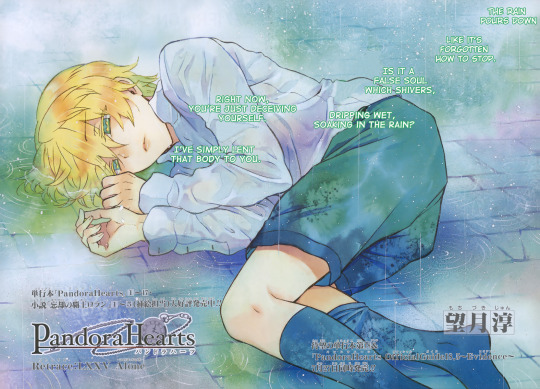
This thought haunts Oz intensely and sends him into a rapid downward spiral. Like the sentiments expressed near the end of the “emotional abuse” section of this analysis, the idea that Oz’s body belongs to Jack is backed up by rigid, literal plot elements. However, if we view this emotional catastrophe using a symbolic perspective, it is a representation of yet another common struggle endured by those with depression.
We come to ask ourselves who we really are. Was there truly a time when we weren’t “like this?” Could we truly escape this misery in the future? Who would we be if we were to stop feeling this way? Do we even exist without depression? Does Oz even exist without Jack?
Visual Symbolism
It is a classic literary device to represent hope through light and despair through darkness. The manga is rife with this exact type of symbolism, utilizing it to describe how the Abyss has changed throughout time, Break’s dwindling eyesight, and the oscillating emotional states of various characters.
As I stated previously, Jack and Oz interact almost exclusively within the latter’s mind. The landscape drawn in the background of these conversations initially possesses a watery, clear appearance. However, as it becomes increasingly clear that Jack’s presence is deeply damaging to Oz’s psyche, this same landscape becomes overwhelmingly tainted by dark, ink-like shadows.
Closer examination reveals that this “pollution” originates directly from Jack--and it reaches its peak once Jack’s intentions have been fully disclosed. Not only is Oz’s mind visibly corrupted by darkness, but Jack himself appears as an almost inhuman figure composed of these shadows.
There is another level of visual symbolism as well--namely, the fact that Jack becomes increasingly physically aggressive and disrespectful towards Oz. In the first half of the manga, he primarily speaks to Oz from a distance, occasionally reaching out a hand in his direction. This is clearly not so in the second half of the manga, at which point Oz begins to defy his influence and it becomes vital that he subjugate him as quickly as possible.
By this time, Jack is almost always seen either restraining or caressing Oz. Even in the latter situation, when his touches are lingering and vaguely affectionate, they are possessive and constraining. In other words, though they appear different on the surface, both actions are ultimately methods of forcing Oz’s submission. It can be said that this represents his desire to gain complete control over all aspects of Oz’s being, as well as his total lack of respect for Oz’s physical and emotional autonomy.
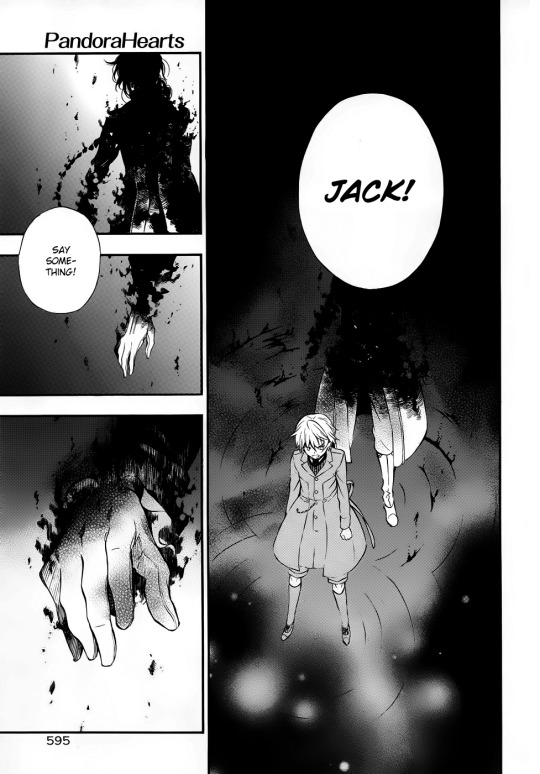
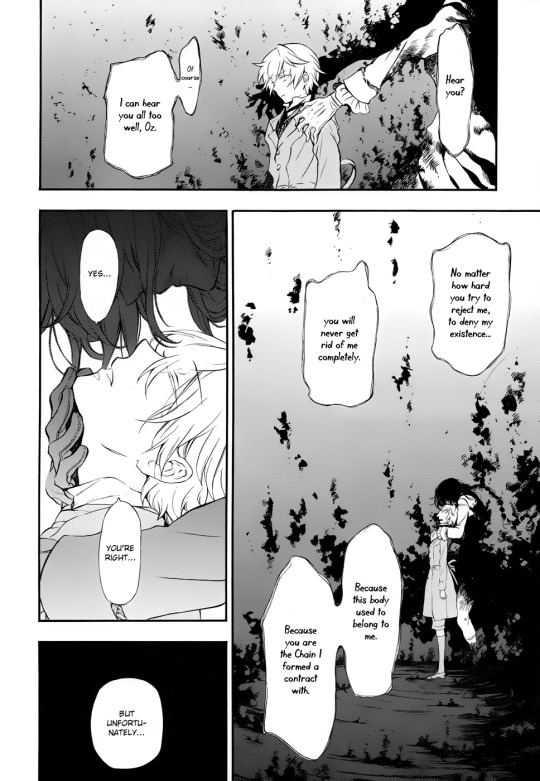
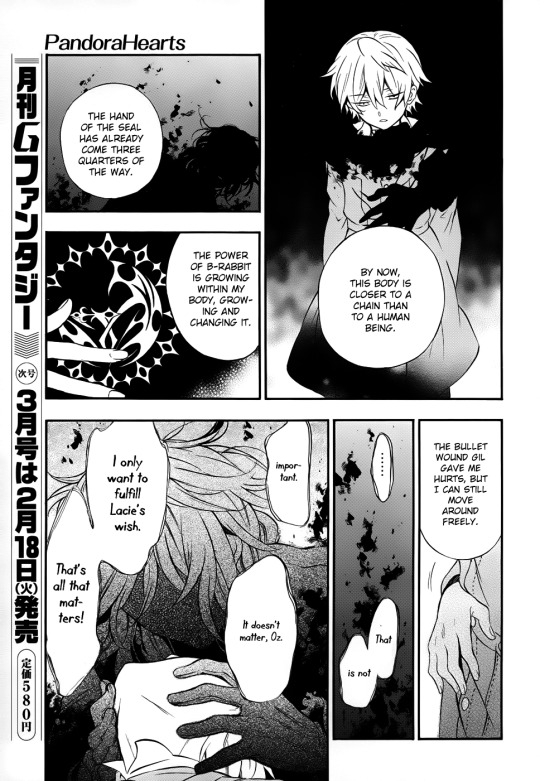
It can be argued that both of these aspects of symbolism reach their pinnacle even before this point. Oz realizes his own worth when Oscar says he loves him and reveals that his greatest desire is for him to be happy. When Oz is at last able to grasp that he is loved and there is hope within his life, Jack immediately reaches out to grab him. And in one of the manga’s subtlest but most poignant moments, his hand crumbles to dust upon touching Oz.
What follows is an extremely impactful display of Oz’s character development. He recalls Jack’s previous statements declaring his achievements worthless, denouncing the love he received from others as fake, and degrading his worth. Then he furiously rejects all of them, thrusting out a hand to push Jack away from him and consuming Jack in an explosion of light.
The conclusion to be drawn from this is that Jack essentially lives off Oz’s misery. When Oz understands and is able to accept that he is not worthless, Jack is suddenly rendered utterly powerless.
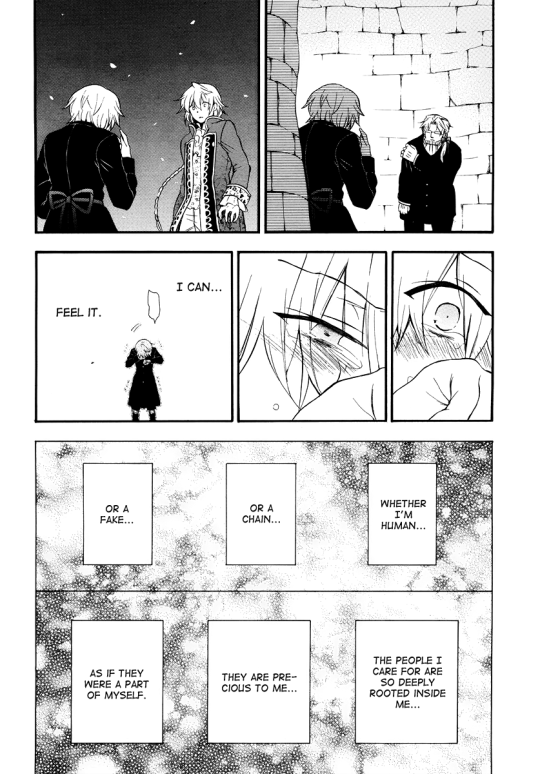
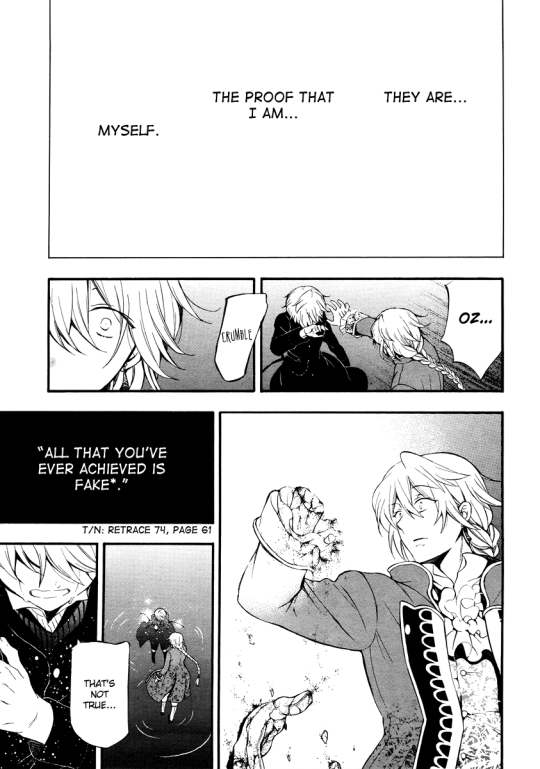
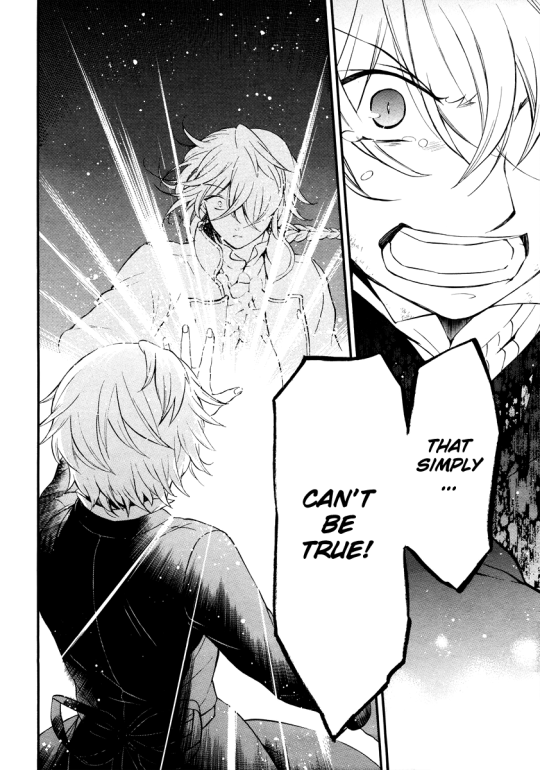
The manga culminates in a scene that coincides with this symbolism. This late into the story, Oz has succeeded in transcending Jack’s influence almost entirely, but Jack is not quite ready to let go. Though they stand together within a void, glimmers of light linger around Oz--despite everything, his life has come to be surrounded by hope and love.
As Oz floats towards the path of light above, Jack reaches out and takes hold of his wrist. But his grip is feeble and hesitant, representing how little control he truly holds over Oz at this point. Perhaps attempting to provoke guilt or regret, Jack asks Oz if he is certain that he is prepared to move on without him, but Oz has grown too much to succumb to this manipulation.
Without delay, Oz replies that there is no reason for him to stay, and Jack finally releases him. He escapes into the light--into a world full of people who care about him, into a life where he is happy to be alive.
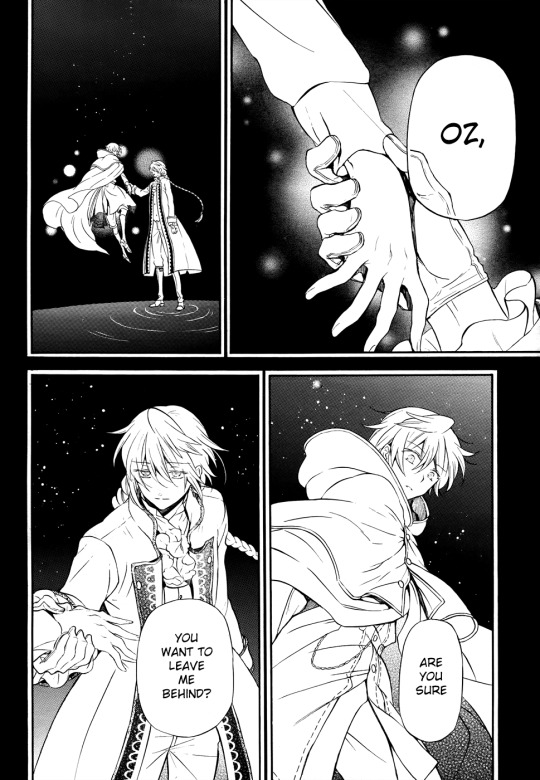
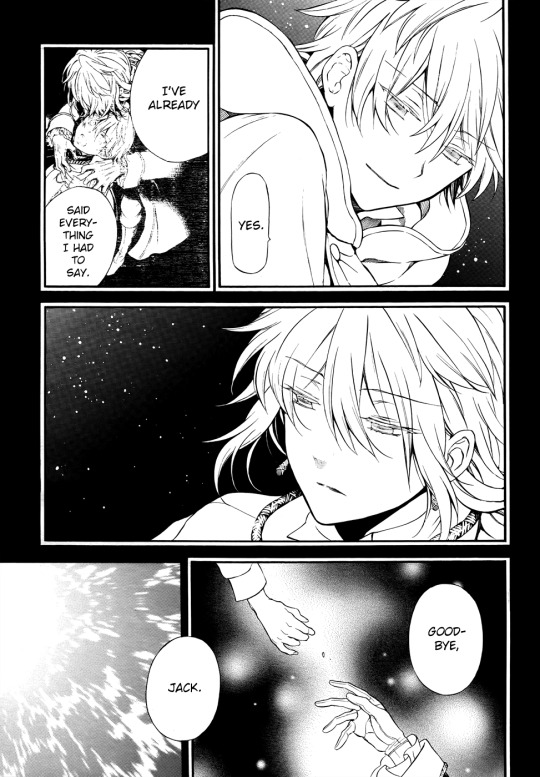
#PandoraHearts#Pandora Hearts#Jack Vessalius#character analysis#Oz Vessalius#analysis#Cyokie's thoughts
161 notes
·
View notes
Note
fab nygmobblepot moments that remind you of kd uwu
OMGGGG AHDAHDUIADHAD
I want to use this moment to be sorry to everyone that follows me but keeps seeing my blog full of Nygmobs/Smaylor instead of kaisoo. I usually don’t get attached to otps like this and it happened in an unexpected way for me. But it’s here and I need to compensate for all the years I didn’t watch Gotham and had no idea about Nygmobs spamming everyone and making my heart warm.
But in general, nygmobblepot isn’t a vision of ideal relationship. Both Edward and Oswald (their surnames Cobblepot and Nygma were the ones who originated this name) are stupid and do stupid shit to each other during most of the series. So, a lot of moments related with the actors counterpart (Robin is the actor who plays Oswald and Cory who plays Ed) reminds me of kaisoo more. But a warning here! Although they have a HUGE chemistry on and off screen, they’re mostly friends. Robin is married for almost ten years so it doesn’t mean their closeness is romantic or sexual. But still, some details remind me of kd.
Similarities with nygmobs:
Height difference: it applies to Smaylor as well because it’s their height but it’s really visible in the series. Cory is a bit taller than JI I think and Robin is like 1.65 but KS is not that taller (I can’t believe he’s 1.73 at all, sorry). But, again, this factor is evident during the series and in some moments and it’s cute.

(the way he moves his feet to reach Ed’s head ;_;)
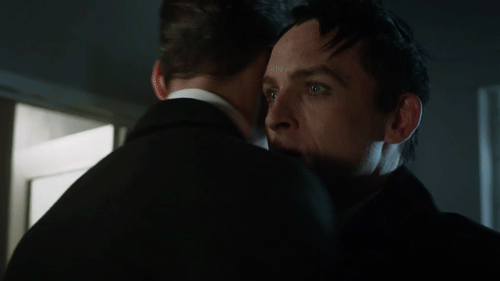
(when they hug, Oswald barely reaches his shoulders [their hugs are the equivalent to kisses in Gotham])
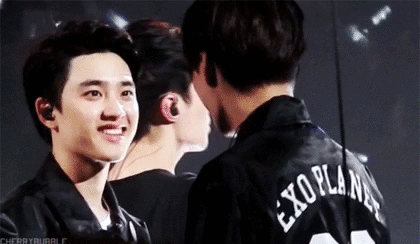
the closest gif I could find where we can see kd’s height difference without me stealing other people’s gifs.
Penguin reference? That’s pretty obvious. Of course I didn’t start shipping nygmobs because one of them is small and has the Penguin nickname but it made so much easier for me to read some of their fics with kd as characters because they fit the profile so much! And also, I believe KD would totally fit the “murder husbands” couple if someone did a fanfic where they just kill everyone. The closest I remember of a fanfic with this criteria is Juice Pouche where Kyungsoo is a vampire and he protects Jongin and Jongin is kind of badass as well. But the kd fandom needs more fics like this. There’s also “(Before the night is over) come see me” where KS is also a vampire and JI a young werewolf but it focuses more on their relationship than a murder husbands idea Gotham shows so well.
How they met: Gotham’s history has a lot of differences if you compare with other universes, so keep that in mind. In Gotham, Ed works with GCPD but doesn’t feel like himself with the good side. Oswald is the character that spices things up and is a rage of death and destruction and manipulation. But Oswald is infatuated with Jim Gordon (so isn’t the first time it’s implied Penguin is gay) but he goes to the police department to see him. Ed sees him and wants to talk to him no matter the cost. And he does that... And things don’t end that friendly for him because Oswald thinks he’s a weirdo and asks him to fuck off, basically. It reminded me of kd’s first meeting where KS was the one admiring JI all along but JI get frightned. But, during their second meeting, they bond and become friends. For Nygmobs it takes more time for their second meeting but they end up developing and being in good terms :’)
Their personas, sort of: Ed is the tall one, younger and logic. Oswald is the oldest, smaller and that thinks with his heart. I love how JI could show the more logic side of himself during the last few years and, again, while reading Nygmobs fics using kd names, it was easy to fit the profile for me (that was during the time I wasn’t too deep into nygmobs and I didn’t knok them that well. KS looks cold and deatached and that’s why many people got impressed when he said, during Knowing Bros that he would choose love over friendship. He doesn’t play the part but, considering all the context, it fits him pretty well and reading this description of Oswald made me so familiar because it fits KD well. Ofc I don’t know their private lives and whatever but it’s just the impression I had as a viewer and random person;
Drama issue: when I say drama here, it’s related with how people percieve the two OTPs and how different people visualize LGBT relationship in media. Nygmobblepot had a lot of drama involved because they’re the fucking Riddler and Penguin, two of the most famous Batman villains. People saw them in different sorts of media before and others idolize those characters because of videogames and comics. So, when Oswald mentioned expressedly that he was in love with Edward, it caused an uproar in the fandom. People accused the producers and Robin of messing with the comic canon because the fucking Penguin became gay??? Robin was outspoken about the homophobia behind those statements since he’s a gay man himself but yeah, the drama existed. Part of the people invovled with the series rooted for Nygmobblepot, including some writers and the actors (Cory was the one with ambiguous messages about the nature of their relationship but it’s not even close what happened with other series like Supergirl, Supernatural and Sherlock). But it was aired by FOX, a right wing channel and, as you may imagine, they didn’t become canon per se. Actually, after Oswald said he was in love with Ed and planned on confessing to him, the writers presented a clone of Ed’s ex girlfriend with no explanation and purpose, only to separate them for most part of the series future. After that, some people seemed to have FORGOTTEN Oswald was once in love with Edward, rationalizing many things that are hard to explain with a “bro explanation”, they had a scene where the characters would have evolved even more but it was CUTTED and CHANGED and execs added the sentence “we’re brothers” to make EXPLICIT that Nygmobblepot’s relationship wouldn’t be interpreted as a romance at the end of the series (but, honestly, the actors went for the romance path anyway, the deleted scenes and the final episode can’t convince me otherwise).
What’s related with KD, may you ask? I think you’re familiar with all the drama KD faced since 2016 and how many stuff exploded during that time. How many parts are involved into creating a certain image and shifting it to be appealing and “friendly” is similar with what happens with idols. It’s no secret now about many scandals of bullying and other issues that are considered problematic and how they need to be pushed under the rug for companies so idols can make money and be profitable. Especially for male idols, it’s important that they are viewed as desirable and an object of the fans affections. That’s why he needs to be handsome and kind and look like a person that doesn’t exist. If an idol is openly gay, this person isn’t viewed by the major public with the same interest because they can’t fit the fantasy. That’s why scandals involving idols being gay need to be forgotten and deleted from people’s minds, otherwise that celebrity is ostracized. Although we tend to see the Ocident as “progressive”, there’s similar things happening in that industry. If a celebrity is openly LGBT, they don’t receive certain roles or opportunities because of it. There’s still a huge stigma that needs to be broken and we, as a society, are so far way from it. But recognizing those differences exist it’s a step forward.
Similarities with Smaylor
For me, one of the reasons Nygmobblepot works so well is because of the actors. They portrait a good chemistry because of their friendship off screen and some non verbal signs they display around each other are amazing. Those are things that remind me more of KD as we see them in a lot of moments. So, I wanted space to show those comparisons below:
Mutual admiration: it’s something both Smaylor and KD display a LOT and is extrememly outspoken. I really love watching their old interviews because the affection and admiration is so genuine it makes me drawn to them despite not being romantically involved.
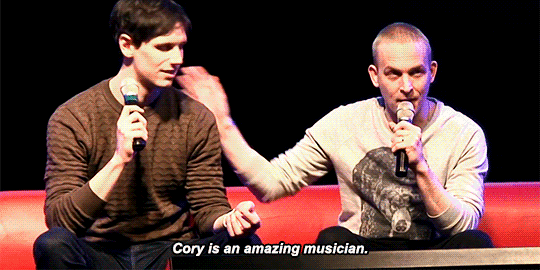
(full gifset)
(there are more moments than these but I don’t want to steal gifs and there’s not much on the gif research and that sucks. Same with KD’s).
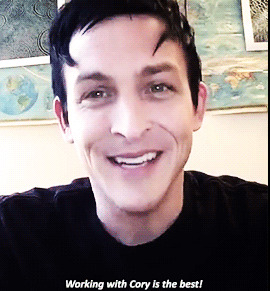
Stares and touches: Robin was the responsible for the deep stares and Cory for the random touches. There’s so many gifs of it that is hilarious. It’s like JI divided himself in two cells because we know he’s more known for both >.<
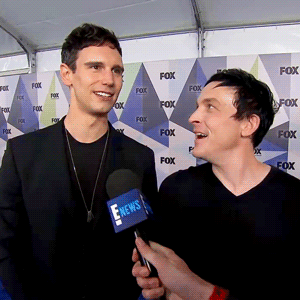
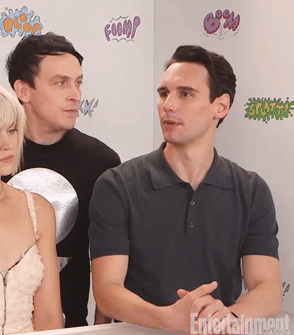
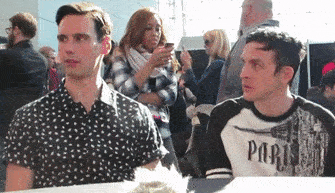
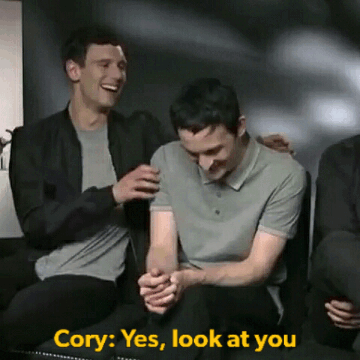
(Cory was touching Robin all the way during this interview rip)
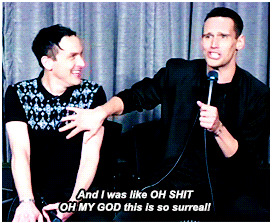
(the gifset!!!)
You’re pretty moment: Robin, like KS, is the one that mentions about Cory/JI’s physical attributes. They have a moment pretty similar and, for KD its famous among shippers:

(gif link)
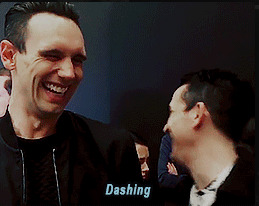
(actually, Robin called Cory dashingly handsome but its okay)
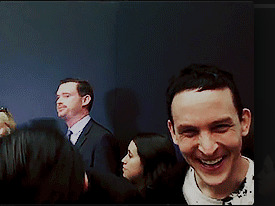
Cory lost it
There’s another series of gifsets with Robin calling Cory handsome LMAOO
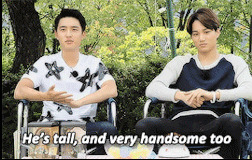
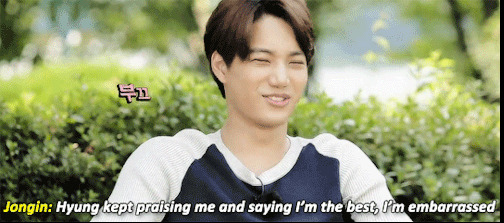
:))))
Synchronization: for specialists in body language, it’s a factor that shows two people are close. That’s because of the mirror neurons we have that makes us copy movements, actions or words that someone we have empathy/we are close with do or say. Both kd and smaylor do this and it’s really soft.
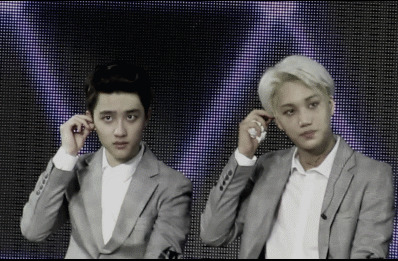
(one of the classics)
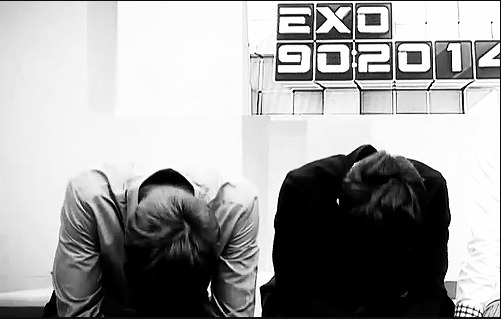
(classic 2)
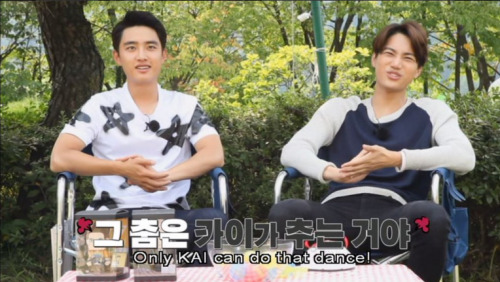
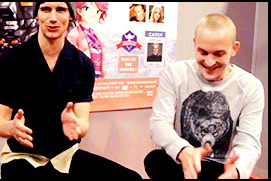
whole gifset (i love this interview so much)
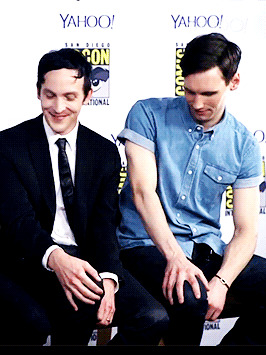
(gif)
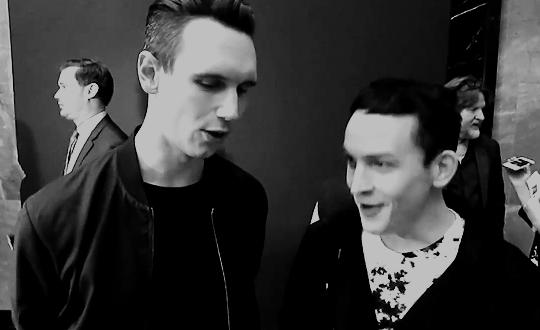
The fact the actors came up with their OTP names: people tend to forget that KD’s real otp name (according with Jongin) is dika. Cory also came up with Nygmobblepot name and Smaylor too <3
So, meanwhile Nygmobs has thropies that work a lot with KD AUs, Smaylor has healthy dynamics seen in public appearances KD made. Like I said above, there’s a huge polemic about shipping Smaylor romantically because Robin is married. On social media, is visible he loves his husband and it’s pretty cute to see. Cory himself mentioned that their relationship was sort of a platonic friendship (whatever that means) but it’s really genuine in terms of affections and display of admiration, something KD has as well.
Probably someone will question that it may changed the way I see KD or if now I ship them as bros. Nothing about that changed. With KD, although there are some similar details, there are internal AND external factors that made me support them in a romantic perspective in the first place. And it didn’t change.
But both of them (Nygmobs too) make me feel that I’m testimoning something genuine, which is really hard in both kpop and media universes. In one side, we have a LOT of fanservice. And, in the other, it’s mostly a work interaction with lots of queerbating. Yes, Gotham has queerbating aspects in it but it’s not full of queerbating, if it makes sense. The message the actors and some writers wanted to convey are there and really display a romantic direction with character evolution and growth. And, considering the way media is nowadays, it’s nice to see.
31 notes
·
View notes
Text

...and the unironic joys of better living through chemistry
How do I love Venom: The Hunger, let me count the ways…
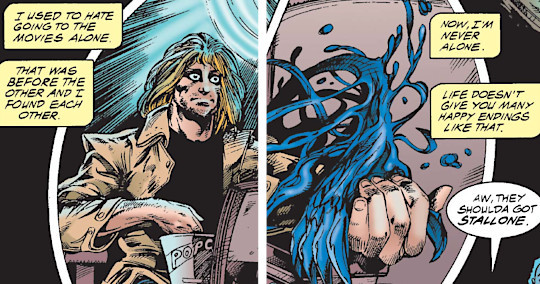
It’s by far the shippiest Venom/Eddie story to come out of the character’s heyday. It’s the only story of the era to treat Venom’s violent wild-animal instincts not as an immutable fact, but as something that can be managed. It pulls off an aesthetic like nothing else that was being done at the time.
And then there’s the way it says, Does the world around you seem sinister and foreboding? Do you lie awake at night contemplating metaphorical oceans of despair? Well shit, son – have you considered you may be suffering from a mundane neurochemical imbalance, and a round of the right meds could clear that right up for you?
It does all this without breaking the atmosphere, without a whiff that our story has been interrupted for a Very Special Message about mental health.
In the near-decade since I was first prescribed anti-depressants, I don’t think I’ve read another story that lands the message “Sometimes, it’s not you, it’s just your brain chemistry,” so well.
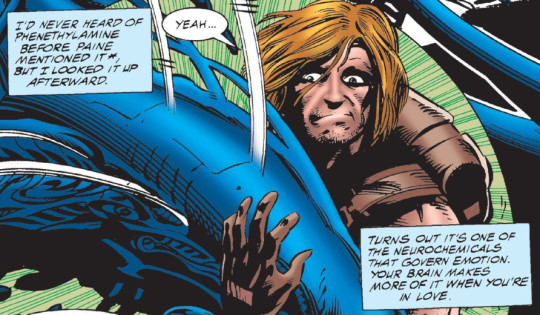
Fair warning: if you have not read The Hunger, I am about to spoil every major plot point. If you have, well, maybe I can still give you a new appreciation for a few details you might have missed.
It’s a strange book, whatever else you take from it. It’s almost the only thing either author or artist contributed to the Venom canon, and it’s so different stylistically and tonally from the 90′s Venom norm that it feels like a tale from some noir-elseworlds setting instead of 616 canon. When you take risks that big with a property, you leave yourself precious little landing space between 'unmitigated triumph’ and ‘abject failure’: if this book hadn’t absolutely nailed it, I’d be dismissing it as edgy, OOC dreck. Fortunately, if The Hunger is nothing else, it is a story that $&#@ing commits – to basically everything it does.
Now, I'm not going to tell you Venom: The Hunger is a story about overcoming depression, because I don't know whether author Len Kaminski even thought about it that way while working on it. There's always space for other readings, and this one take is not gospel. That said: holy shit is this thing unsubtle with its metaphors. And with that in mind, let’s start by talking a little about Kaminski’s take on Eddie himself.
As I may have mentioned before, I like to divide 90′s Eddie into two broad personas: the Meathead, and the Hobo.

Kaminski’s Eddie nominally belongs in the angsty, long-haired Hobo incarnation, but that’s a bit of a simplification: this version certainly has plenty of angst and plenty of hair to his name – but nowhere, not even at his lowest ebb, does he doubt that he and his Other are meant for each other, which is usually Hobo!Eddie’s primary existential quandary.
He’s also taken up narrating his own life like a hardboiled PI.
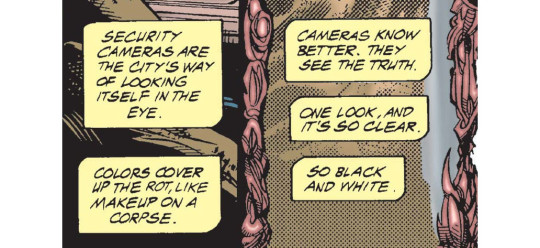
So that’s... novel.
The only other time Eddie’s sounded like this is, er, in that one other Venom one-shot Kaminski penned (Seed of Darkness, a prequel that sadly isn’t in The Hunger’s league), so I think we can safely file it under authorial ticks.
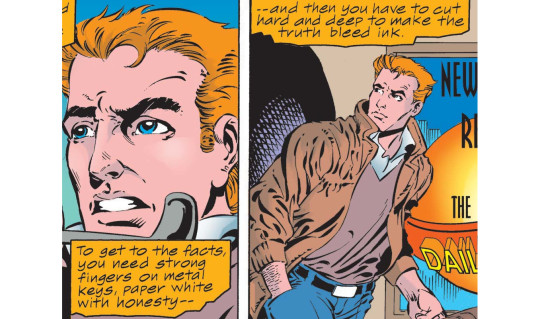
Then again, Hobo!Eddie’s always been one melodramatic SOB, so maybe this is just how he’d sound after learning to channel his angst into his poetry. You can’t argue it fits the aesthetic, anyway.
We’d also be remiss not to mention Ed Halsted’s art, which I can only describe as gothic-meets-noir-meets-H.R.-Giger. Never before or since has the alien symbiote looked this alien: twisted with Xenompoph-like ridges and veins.
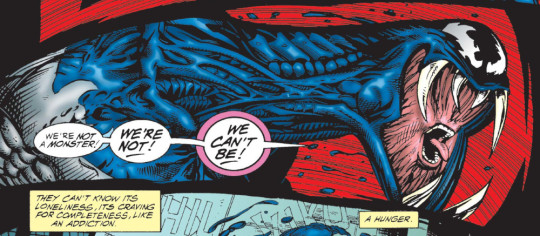
But Halsted doesn’t treat Venom to all that extra detail in every panel. Instead, the distortion tends to appear when the symbiote is separated from Eddie or out of control – and I doubt you need me to walk you through the symbolic importance of that creative decision. More importantly, Halsted’s art provides exactly the class of visuals that Kaminski’s story needs.
Did I mention this is a horror story? You might be surprised how few Venom stories really fit that genre, but if all those adjectives about Halsted’s style above didn’t clue you in, this is one of them.
Anyway, with that much context covered, let’s get into the main narrative of this thing.
As our first issue opens, Eddie’s world has become a dark and foreboding place. He’s not sleeping, though he mostly brushes this off. (Fun fact: trouble sleeping is one of those under-appreciated symptoms of depression. Additional fun fact: the first doctor ever to suggest I might be suffering from depression was actually a sleep specialist. You can guess how that appointment was going.)
Just to set our scene, here’s all of page 1.
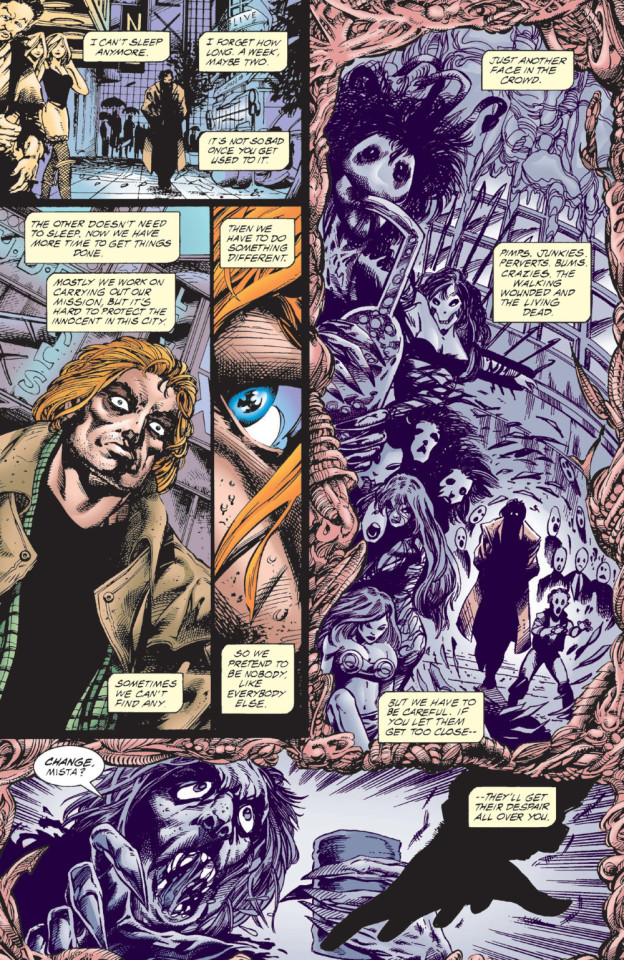
Eddie’s narration has plenty of (ha) venom for his surroundings, but the visuals are here to back him up: panels from Eddie’s POV are edged in twisted, fleshy borders and drained of colour, the people rendered as creepy, goblin-like creatures. A couple of later scenes go even further to contrast Eddie-vision with what everyone else is seeing:
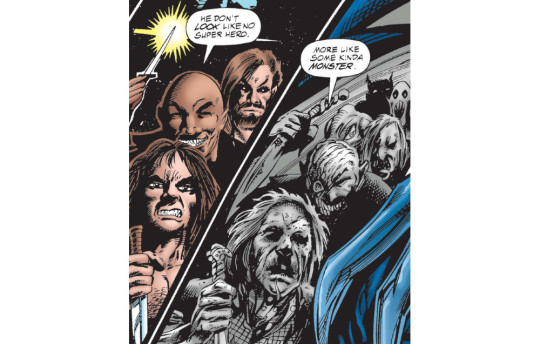
As depictions of depression go this is a little on the nose, but then, you don’t read a comic about a brain-eating alien parasite looking for subtlety, do you?
Eddie doesn’t see himself as depressed, of course. As far as he’s concerned, he’s seeing the world’s true face: it’s everyone else who’s deluding themselves. He’s still got his symbiote, so he’s happy. He’s yet to hit that all-important breaking point where something he can’t brush off goes irrevocably wrong.
But he’s also starting to experience these weird... cravings.
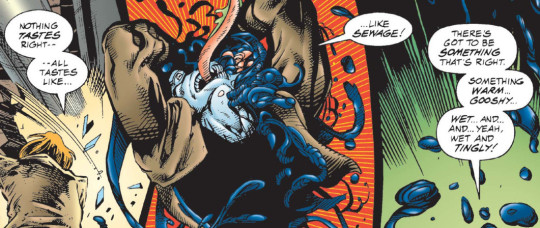
He just can’t put a name to exactly what he’s craving until a routine bar fight with a couple of thugs takes a turn for the horrific.

(I include this panel partly to point out even in The Hunger, the goriest of all 90′s Venom titles, you’re still not going to see brains getting eaten in any graphic detail. We don’t need to to get the horror of the moment across. The 90′s were a more innocent time.)
Eddie himself is horrified when he comes back to himself and realises what he’s done.

Or rather, what his symbiote’s just made him do.
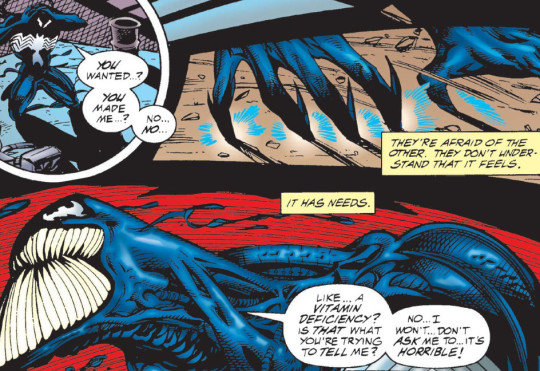
Kaminski doesn’t keep us in suspense about why, though. Eddie may have just done something horrific, but there’s a reason, and it’s as mundane as a vitamin deficiency. He’s bonded to an alien creature, after all, and his symbiote is craving a nutrient which just happens to be found in human brains. And if Eddie can’t or won’t help it meet that need, it’ll do so alone.
Now, giving us that explanation so quickly is an interesting creative decision: this is a horror story, and horror lives in what we don’t know. Wouldn’t it be all the more horrifying had the symbiote been unable to explain what’s going on, leaving Eddie without the first real clue as to where this monstrous new hunger had come from?
The Hunger doesn’t take that route though, and I love it. Eddie isn’t a monster, this isn’t his fault: he has a fucking condition, and wallowing in his own moral failings is going to get him nowhere. You might as well try to cure scurvy or rickets with positive thinking. Just like depression can make you feel like an utter failure at the most basic parts of being human, and all the affirmations in the world won’t fix it when it’s fundamentally your brain chemistry that’s the problem. Or like addicts aren’t weak-willed for struggling not to relapse, they’re dealing with genuine chemical dependency – or even like how someone who’s trans isn’t at fault for being unable to reconcile themselves to the bodies and the hormones they were born with by pure force of trying. Free will is more than an illusion, but we’re all messy, biological organisms underneath, and your own brain and biochemistry can and will fuck you over in a hundred wildly different ways for as many wildly different reasons and it’s not your fault.
We aren’t monsters. But if we do, sometimes, find ourselves identifying with the monster, there might be a reason for that.
(Ahem)
I’m just saying, that’s fucking powerful, and we need more stories that say it.
Anyway, in case you missed it during that tangent, issue #1 closes with the symbiote having torn Eddie’s heart in two itself free to go hunting brains without him.
I’m trying not to get too sidetracked at this point talking about Kaminski’s take on the symbiote itself. Suffice to say there are broadly two schools of thought on how it ought to function while separated from its host: the traditional ambulatory-slime-puddle version, and the more recently popular alternative where anything-you-can-do-with-a-host-you-can-also-do-without-one. I’m not much of a fan of the latter, personally: if your symbiote doesn’t actually need a host, I feel you’ve sort of missed the point. (The movie takes the route of saying symbiotes can’t even process Earth’s atmosphere without a host, which is a great new idea that appears nowhere in the comics, and I love it. Hosts or GTFO, baby!)
Kaminski has his own take, and I can only wish it had caught on. Without Eddie, the symbiote becomes an ever-shifting insectoid-tentacle-snake-monstrosity, driven by an animalistic hunger. It’s many things, but it’s never humanoid.
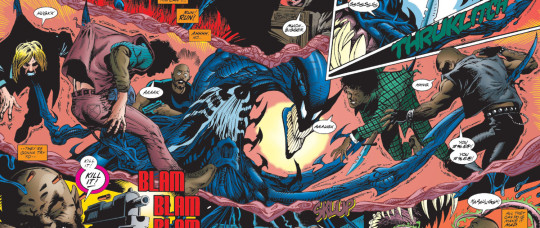
If you absolutely must have your symbiote operating minus a host, I feel this is the way to do it: semi-feral, shapeless and completely alien (uncontrollable violence and cravings for brains to be added to taste).
Issue #2 comes to us primarily through the perspective of the mild-mannered Dr. Thaddeus Paine of the Innsmouth Hills Sanitarium (yes, really).
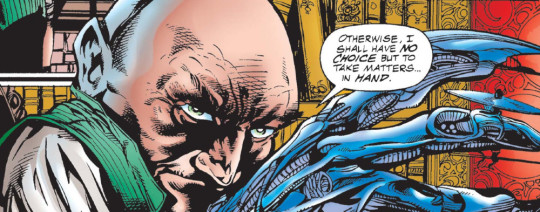
Yeah, he’s not fooling anyone. Meet our official villain! He joins our story after Eddie is picked up by the police and handed off to the nearest available institution, on account of how completely sane and rational he’s been acting.

Naturally, Dr. Paine soon has copious notes on Eddie’s ‘crazy’ story about his psychic link to a brain-eating alien monster. Fortunately for Eddie, Paine also runs some tests and makes an interesting discovery.
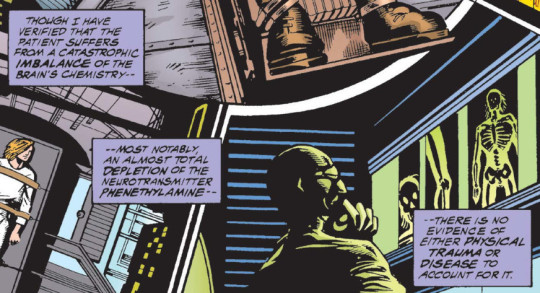
Congratulations, Venom: the ‘vitamin’ you were missing officially has a name!
Finding the right meds isn’t always this easy. I got lucky – the first ones my psych put me on worked pretty well – but I have plenty of friends who weren't so lucky. In fact, the treatment for Eddie's problems is so straightforward it arguably has more in common with, say, endocrine disorders like thyroid conditions or Addison’s disease, which differ from clinical depression but present many similar symptoms (but can sadly be just as much of a bitch to get correctly diagnosed – please do read author Maggie Stiefvater’s account of the latter when you get the chance, because forget Venom, that is a horror story).
‘True’ depression remains much less well understood by medicine, either in its causes or how to effectively treat it. But simply having a name for what was wrong with me made so much difference, and that’s an experience I imagine anyone who’s dealt with any long undiagnosed medical condition could relate to. It put my life in context in a way nothing else had in years.
(I can’t speak to the accuracy of the way phenethylamine is portrayed in this comic – a quick google suggests there may be some real debate that phenethylamine deficiencies have been overlooked as a contributor to clinical depression, but having no medical background, that one’s well beyond me. Either way, scientific accuracy really doesn’t matter in this context – it’s how it works in-universe for story purposes that we should pay attention to.)

Since this issue is mostly from Paine’s POV, we don’t get Eddie’s reaction to having a healthy amount of phenethylamine sloshing around in his brain again, just the assurance that treatment appears to be ‘completely successful’.
He’s still a paranoid, hostile bastard though. Meds can turn your life around, but they won’t make you not you.
But even if Eddie’s feeling better, he’s still psychically linked to someone who isn’t. Symbiote-vision still comes through drained of colour and edged in viscera.

That’s the thing about meds: they won’t solve all your problems overnight. If you’ve been depressed for a while, there are good odds you have problems stacking up. But working meds can be a godsend when it comes to getting you into a space where you can deal with your problems again, whether said problems are doing-your-laundry or all the way into not-giving-up-completely-and-just-accepting-you’ll-die-alone-on-the-street.
For Eddie, ‘dealing with his problems’ begins with stealing a keycard and busting out of the asylum.
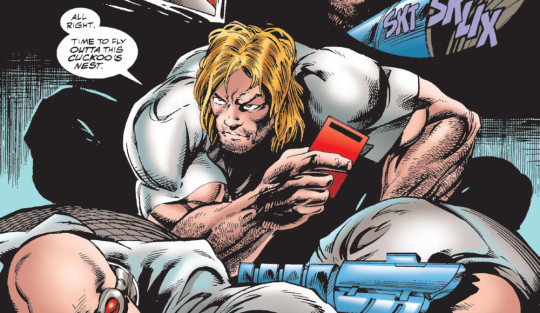
Of course, that’s the easy part. How do you solve a problem like a feral symbiote? Like any good 90′s comic book protagonist, Eddie tackles it by putting on his big-boy camouflage pants and kitting himself out with weapons and pouches while quoting “If you live something, set it free. If it doesn’t come back, hunt it down.”
We can add this to the list of things I love about this comic. Even if The Hunger is a weirdly-stylistic tract about depression at heart, it’s also still a goddamn 90′s Venom comic, and not ashamed to be.

We’re into issue #3 now, and back to hearing the story from Eddie’s POV.
Eddie is very much aware that his symbiote has murdered innocent people while they’ve been separated. Even if this is the result of extreme circumstances, there’s a good case to be made that the symbiote is too dangerous to be allowed to live. Plenty of heroes would treat it like a rabid dog at this point.
But Eddie isn’t a hero, he’s a mess of a character and an anti-hero at best, so we don’t have to hold him to the same standard. He’s well aware his symbiote may be too far gone to save, that he may have to put it down – but that’s only his backup plan. He wants to help it. He wants it back. He’s down in that sewer with screamers and a flamethrower because he knows all his symbiote’s weaknesses, but he’s also carrying a large jar of black-market synthesised phenethylamine, because if he can just get close enough...

Depression can’t make you a literal monster, but it can make you an asshole. Miserable to be around, lacking even the energy to care who else you’re hurting. The depression doesn’t excuse that, but it makes everything harder, and it’s that much easier to sink back into your spiral when everyone around you has given up. It can make you think everyone around has given up even if that isn’t true.
So to have Eddie here say, in effect, I don’t care how many people you’ve eaten, I know it wasn’t your fault. I still love you. You’re still worth fighting for – god, does that get me right in the id.
There’s still a whole issue left at this point – we’ve still got to deal with our real villain, Dr. Paine, who we’ve just learned is into eating brains himself and torturing his patients recreationally, and who wants to capture the symbiote for his own purposes. There’s the scene where Eddie and his symbiote finally bond again, and Venom beats up all Paine’s goons while singing David Bowie because like I said, this is still a 90′s superhero comic and this is what Venom does.
But for our purposes, I'm going to skip to the penultimate page of the story, because the way it mirrors our opening page is really lovely.
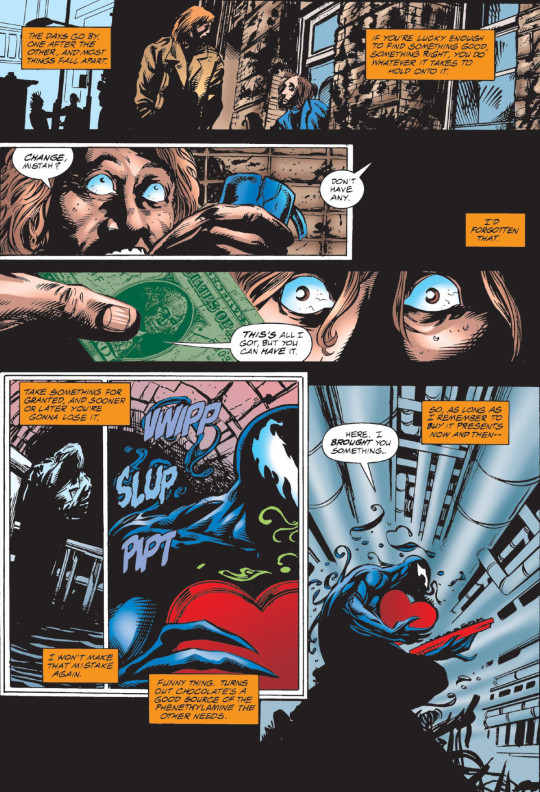
Remember that shot of Eddie dealing with a beggar back at the beginning of the story, thinking about how these people would 'get their despair all over you'? Here he is again, cheerfully forking over the last dollar in his pocket to the next man to ask him for change. For all the gothic atmosphere and gore, it’s moments like this that make The Hunger easily one of the most positive, uplifting Venom stories ever written. Funny, that. (I could probably write a whole other essay on sympathy for the homeless as a recurring motif in Venom stories, but that... well, whole other essay and all that.)
What’s Eddie learned from this experience? Don’t take your symbiote for granted. Is ‘symbiote’ a metaphor for mental health here, is paying attention to its needs an allegory for paying attention to your own? I still don’t know how literally Kaminski meant us to take this, but it’s a lovely note to end on no matter how you parse it.
At the end of the day, The Hunger isn’t flawless. The conflict with Paine ends on a thematic but slightly unsatisfying note. Eddie makes much of his symbiote's loneliness and desire for union, but when the two of them are finally reunited, the only reaction comes from Eddie's side. In fact, the symbiote seems to have no response to being able to return to Eddie at all, and that’s an omission that bugs me.
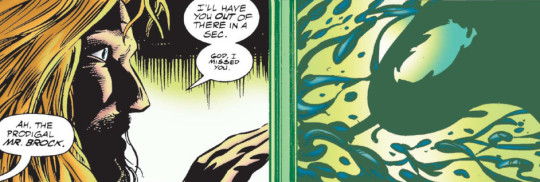
But Kaminski is more interested than any other writer of the era in the truly alien nature of the symbiote, in its relationship with Eddie from Eddie’s side, and though plenty of others talk about the symbiote's love/hate relationship with Spider-man, no-one else had the guts to portray their relationship this much like a romance.
And Venom: The Hunger is no less interesting in the context of Len Kaminski’s other work. You don't have to look far into his Marvel and DC credits to pick up that the guy has a real thing for monsters. (“All of my favourite characters are outlaws, misfits, anti-heroes,” he says, in one of the very few interviews I could find with him, “I wouldn't know what to do with Superman.”) He's written for vampires, werewolves, victims of mad science, and all of three at once, littering his work with biochemistry-themed technobabble, melodramatic monologues, gratuitous pop-culture references, and protagonists who must learn to embrace their inner demons. So The Hunger represents more than a few of his favourite running themes.
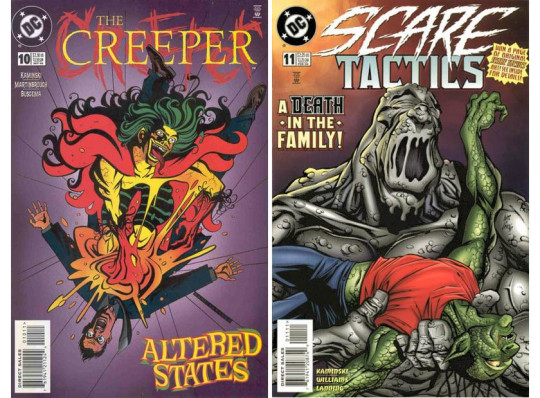
For our context, his more notable other work includes Children of the Beast, in which a werewolf must make peace between his human and animalistic sides, and The Creeper, in which a journalist must make peace with the crazy super-powered alter-ego sharing his body. In fact, The Creeper and The Hunger share so much DNA (including an evil doctor posing as a respected psychiatrist who uses hypnosis on our hero while he's trapped in a mental institution) that it’s quite the achievement that they still feel like such very distinct entities beyond that point.
The human alter-egos of both werewolf and Creeper even use prescription meds while wrestling with their respective dark sides. The difference, in both cases, is that these are stories where meds play their traditional fictional role – and that's a role that could be as easily filled by illegal drugs or alcohol without making any substantive difference. You see, if a protagonist is using them, it's a sign of unwillingness to tackle their 'real' problems. Even among work by the same author in the same genre, The Hunger represents an outlier. And that's just a little disappointing – at least to me.
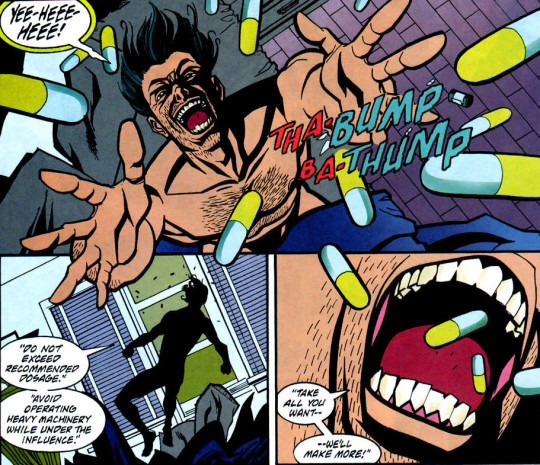
In real life, of course, prescription meds are no magical cure-all elixir. Depression meds that work for one person may not work for another, or may not keep working in the longer term. Everyone has heard stories about quack doctors who prescribe them to the wrong patients for the wrong reasons, about lives ruined by addictions to prescription painkillers, or the supposedly-damning statistics about how poorly SSRI's perform in rigorous clinical trials. The proper way to treat depression is obviously with lifestyle and therapy. People will still airily dismiss medications that we all know previous generations got along just fine without, or suggest that figures like Van Gogh would never have created great art if they hadn't been mad enough to slice off an ear. I mean, the fact you think you need those bogus mediations is probably the best possible sign of just how broken you are, right? Who do you think you’re kidding?
Our popular fiction loves stories about manly men who bury their trauma under a gruff, anti-social exterior and come back swinging at the world that broke them, bravely refusing even painkillers that might dull their manly reflexes. Other genres make space for broken people confronting their demons in grand moments of catharsis, finally breaking down into tears when someone gets through to make them face their problems. "I could barely make it out of bed in the mornings until I found a doctor who started me on this new prescription" is not only wildly counter to the accepted social narrative, it's a hard thing to know how to dramatise.
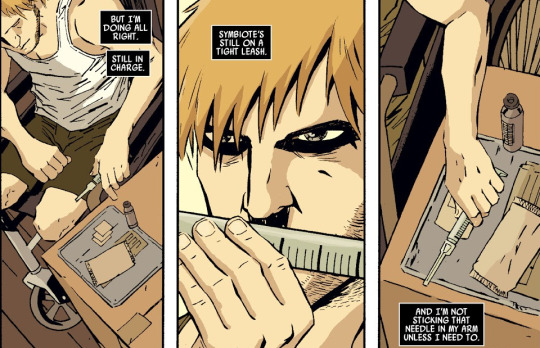
Even other Venom comics have been guilty of this.
Believe me, I recognise all of this, and just how much progress we've made in the last few decades. But I haven't the slightest doubt that for so many vulnerable people, the stigma against prescription medications does infinitely more harm than those same meds could ever do. And just having the right to externalise my problems into it's not you, it's your brain chemistry, may have helped me more than the meds themselves.
(And again, no, being prescribed SSRI's didn't fix me overnight, but I honestly don't know if all the talk therapy and tearful conversations with family members in the world could've got me as far as I've come without them.)
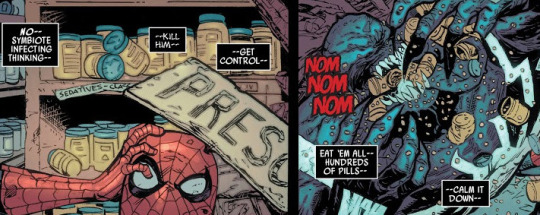
I love Venom: The Hunger. It's no-one's idea of high art, but it doesn’t need to be. There is a whole other post’s worth of things I love about it that I’ve already cut out this one as pointless tangents, and that may actually be it’s biggest drawback as a go-to example: I fully recognise that I would not be making this post if The Hunger hadn't also also grabbed me as a great bit of Venom canon, being the massive fan and shipper that I am. Other people who are just as desperate as me for more stories with the same core theme, but not into weird 90's comics about needy goo aliens, probably won't get nearly as much out of it as I have.
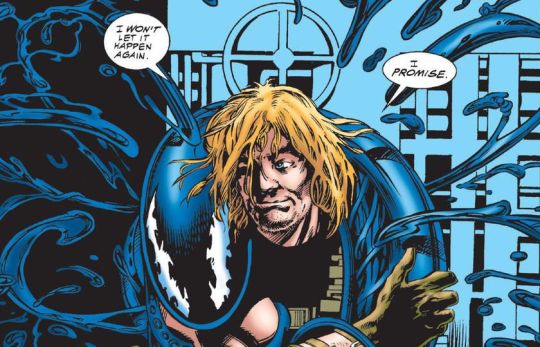
But if it sounds anything like your jam, maybe you'll enjoy it as much as I did.
If nothing else, it proves that you can make a viscerally satisfying story out of a message that shockingly unconventional. And you may even have people still discovering it and falling in love with it 25 years after the fact.
98 notes
·
View notes
Text
Fashion Rant: Alastor Edition
There are two characters that I find the most visually grating: Alastor and Vox (they can fight over who wins first place). But this rant is all about Alastor, as asked for by @ckret2
I love the characters, don’t get me wrong. But a rant is a rant. To preface this entire spiel, it’s worth noting that not all things that look good in real life look good in animation (and vice versa). Usually, though, the disparity between their visual appeal across both mediums isn’t that large. BUT THIS. It’s already hanging on by a thread in the cartoon. I cannot for the life of me imagine this ever existing in real life AND looking good.
I will try to break his outfit down and format it so that this is all easier to understand. Fair warning: in total, this is about 1400 words roasting our beloved demon.
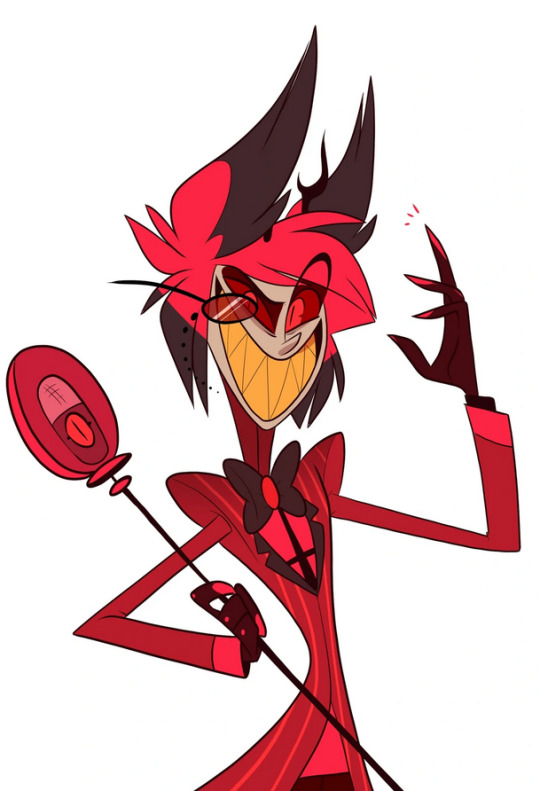
Overall Issues
The Fit: Suits from the 1900s and the next several decades are looser and cut a boxier figure (I’m talking American fashion, specifically). I find fit just as, if not more indicative of time period compared to a lot of other key visual indicators (which can sometimes be shared by decades far apart)
The Color: I think we can all agree he’s too red. Too much red. I love the color red but damn. As elaborate suits were at the time, suits in that color family were closer to a duller red/maroon, with the brighter reds either being in the tie, pocket square, boutonniere, or other accessories. Borderline monochromatic suits also weren’t in vogue. More colors meant a more elaborate look, and a more elaborate look meant you were fashionable.
Too many fabric/color changes within the same garment (I’ll get into this in a later)
Lack of accessories: Although much of this is down to personal preference, the general vibe was that you had at least some bling on you.
I will say, however, that despite the excessive use of pinstripes in other characters, the one character they are bang on for is Alastor. Pinstripes were incredibly fashionable starting the 20s and I think tapered off somewhere in the 50s.
Specific Elements
The Collar & Coat
I’ll start with the collar. I’m treating this as a separate entity since I can’t surely say if it’s a part of the coat OR the shirt.
There are two options: Either his shirt has a bright red body that transitions into a dark red standing collar, or (this one is more likely) the coat closes up again at the neck, meaning there are two useless flaps of stiff fabric masquerading as lapels at chest height.
From the perspective of garment construction, lapels are meant to support and decorate the suit at the neck opening. The presence of ANOTHER method of jacket closure much higher up the neck make the lapels redundant and confusing, not to mention the fact that they’re in an entirely different fabric/color.
So to me, not only is this nothing but a glorified, decorated boob window (watch out, Angel Dust). But also a pointless one since we don’t even see his chest, but instead that thing, that shirt underneath.
The tattered ends of his coat seem to be a matter of choice since they don’t appear on any other character. So either the coat is incredibly old and it hasn’t been repaired due to possible sentimental value, or this is some thinly veiled nod to something we don’t know yet. The tattered bits, on top of the rest of his coat, are a lot.
The Cuffs
I thought at first that the bright red bits on the coat were the ends of the shirt, but then I found this reference image showing a smaller black cuff on his left hand and none on the right.
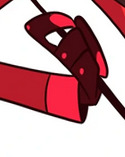

That means 3 things:
That the Ugly Shirt changes color AGAIN (from red to black) at the cuff (Why????)
That the jacket changes color and/or fabric at the cuff (WHY????????????. This makes me want to set them on fire. I can’t even find an example of a suit jacket changing color just at the cuff. That’s how bad it is. Even bad clothing designers in real life know NOT to do it. It makes your arm look shorter than it actually is); and
That the shirt cuff migrates to and fro, sometimes hiding under the jacket and sometimes showing, which is borderline a sin in menswear. Any tailor worth their salt keeps the cuff of the shirt showing regardless of the arm position of the person wearing the suit (conventionally by about ¼” past the jacket cuff at resting position, if my knowledge serves me correctly). Just imagine a guy in real life without the shirt cuff showing past the jacket – in some way he looks nakey.
So, a summary of the Hideous Coat: has two different closures (a standing collar AND separate lapels), a boob window, is made up of FOUR different fabrics (pinstripe body, plain red sleeves & collar, dark lapels, and bright cuffs), and a tattered hem.




A side note: Because I see people drawing men in suits with a lot of folds in it. A suit, since it’s conception, has always been meant to cut a dignified and elegant figure. Unless it’s made of light fabrics usually used in summer suits, like silk or linen, THAT MANY folds just means the suit is incredibly poorly made. (especially when you see the sleeve twist. That is the worst offender. Why waste gasoline when you can use that suit jacket to start the fire instead).
The Shirt
Several people have already mentioned this, but the shirt is UNtucked (I concur – unacceptable), has this cross emblazoned on the front, has said cross end in the middle of the shirt, and, as we have now established, changes color at the cuff. Now, differently colored shirt cuffs do work. But the only good examples that I know of are a more colorful shirt body (usually a pale pastel or another soft color), and white cuffs (sometimes with the matching white collar). Graphic elements in menswear like the cross also didn't really exist on garments until about the 50s/60s, but even then not on dress shirts, just sweaters and cardigans.
I saw someone mention the use of a dickey – which only works if Alastor has some sort of vest or waistcoat involved. But since we don’t see any indication of a vest, I’m just going to assume that the bits we see exposed are all parts of one shirt. *shudder*
All things considered, I think that the Ugly Shirt is definitely the lesser offender of Alastor’s Hot Mess Outfit compared to the Hideous Coat. I say lesser offender because if you tuck this shirt in and add a couple accessories, then immediately it’s already not the worst thing you’ve seen on this planet. That coat is a different story.
The Pants
His pants should be tapered at the ankle, not flared out. However, a loose pant leg of approximately the same circumference all the way down would also be acceptable.
On to the accessories
Monocle: its presence I don’t have as much of a problem with as I do its color. The metal bits I find are hard to see against the dark bits of his hair (not to mention that shinier metallics were more of a norm then compared to the duller finish we see on Al’s monocle). But also WHY would it be tinted?????? Hell already seems red as fuck. WHY do you need a red tinted monocle????
Bowtie: WHY is the knot a different color????????? Hand tied (hell, even pre-tied) bowties are made of ONE fabric all the way. Unless this is one of those artisan clip on bowties using feathers or other unconventional materials (but it doesn’t look like it).
Gloves: The closest thing I can think of for these gloves are modern driving gloves. Driving gloves have holes along the knuckles that either show skin or a different fabric. (However, driving/men’s gloves back then didn’t even look like that. Just short, solid leather gloves with seams on the back of the hand). I have no excuse for the tips. To me they look like those tips you have so you can use smartphones despite glove usage. But we all know Alastor would never.
Speaking of the gloves, there’s something going on between Al & Vox and Al & Sir Pentious. We all know Viv likes to repeat a certain theme across characters with connections, like hearts with Angel, Valentino, Cherri, and Husk. Alastor, Vox, and Sir Pentious all have the exact same glove design. We all knew they had beef, but this is just visual confirmation in the character design.
I almost forgot his hair: Sure, the undercut may have been popular at the time, but that was in tandem with slicked back hair. An undercut + that rag of a mane Alastor has going on is just so confusing to me. Again, WHY???????
His outfit confuses me to no end and whenever I draw his canonical outfit I have to actively shove away thoughts of “BUT WHAT IS THAT? WHAT IS THIS CONNECTED TO? WHY THIS COLOR?” otherwise I risk having an aneurysm.
#I tend to not be too judgmental because Creative Freedom#I will support anyone's desire to experiment creatively#but when asked for hard opinions regarding design I usually have at least some#also to that person who said we were just jealous about Alastor looking better than us#I'll have to say NO to that :))))))))#I'll vouch for literally almost every person on this platform#that chances are they DO look better than our beloved radio demon#hazbin hotel#alastor#please forgive my shitty drawings for the jacket mechanics bit#I mean I know most of you don't mind but I do
430 notes
·
View notes
Text
Belos and the Emperor’s Guard
I don’t have an exact idea of what Belos looks like underneath the mask- But generally speaking, I imagine his ‘face’ to be less a face, and more a discombobulated mass of flesh, bone, and sharp teeth clumsily mashed together, with at least two eyes that may or may not have come from an Emperor’s Guard, and not himself. I mean, come on- Belos already has cannibalistic motifs, and he seems to be experiencing organ failure on a body-wide level. A transplant is not out of the question, especially since we’ve seen him replace his own bile stores with a Palisman’s….
And honestly, that last part makes me wonder what’s the deal with the Emperor’s Guard. It’s interesting that Belos’ eyes seem to take cues from them, whilst we know that members of the Emperor’s Coven are witches that can come in a wide variety of shapes, sizes, and eye colors. The Emperor’s Guard is a bit more unusual, as we can actually see a part of their body; And that part seems equally uniform throughout all of their numbers. There’s the not-mutually-exclusive possibility that Belos’ current set of eyes came from an Emperor’s Guard (and that he routinely replaces them as they decay and rot), but looking at his creations…
His constructs are different from Abominations. They’re very much fleshy, composed of veins, muscles, and viscera. The things that Belos creates are alive, and come across as less magical than your typical Abomination, with not as much reliance on magic to animate them, particularly with mostly-functioning muscles and veins. The Intro Worm that Belos spawns seems to be a somewhat autonomous, living creature; I could see it being its own genuine organisms separate from Belos, AKA something that would fall underneath Beast Keeping magic, VS Abominations.
And while we haven’t seen much, it seems Beasts are less controllable than Abominations, though they make up for it by coming in a much more diverse range of abilities and shapes. Given their unanimous appearance, I have to wonder if the Emperor’s Guards are actually fleshy, living constructs, made by Belos himself, constantly churned out? Unlike Abominations, these ‘constructs’ are fully living with proper organs and brains, which allows them to be a lot more autonomous, creative, and less dependent on Belos’ constant maintence and control to operate; But it could also mean the development of free will, and thus receding loyalty when it comes to Belos’ cause, especially when spread thin across the Boiling Isles and having less direct contact and oversight from their creator. Hence, some guards not being overtly-strict to the law, expressing their own individuality, and even supporting Wrath’s attempted hook-up with Eda, which should be illegal. Granted, Belos didn’t care about Eda until after he learned of the portal, which could’ve been post-Episode 1, but still.
Though they’re made by Belos as a reliable source of soldiers that he can rely upon himself for, the Emperor’s Guard seems pretty weak compared to witches. No doubt effective in reigning in the powerless denizens of the Boiling Isles… But it seems that with Belos’ own bile stores constantly depleted as-is, it’s out of his capabilities, or at least immensely impractical, to create a magic-wielding witch from scratch. Overall, it just makes more sense to recruit his witches from the pre-existing people of the Boiling Isles, to serve in his Emperor’s Coven as his elites; Being much more powerful than an Emperor’s Guard, and more loyal- Or at least AS loyal. If Emperor’s Guards are capable of free will, then that makes them not much different than children who’ve been indoctrinated by Belos’ propaganda from an early age.
However, there’s also the possibility that the Emperor’s Guard are all regular people, but upon recruitment, they undergo a magical transformation to fit an ideal mold that is potentially stronger than you average citizen. Belos is already altering his citizens’ bodies without consent by applying his bindings and making them law- I wouldn’t put it past him to be particularly controlling when it comes to his own forces. For all we know, the appearance of the Emperor’s Guard, or at least what little we see of them, is a reflection of Belos’ own features, or how they used to look like before he became so decayed.
This also lends to the idea that perhaps the Emperor’s Coven witches are like this- You just can’t tell, because like their Emperor they’re closer to than anyone else, they obscure and cover themselves head-to-toe. There seems to be less stict indoctrination and control amongst the Emperor’s Guard, so this can be visually reflected by having them expose their eyes; But for the Emperor’s Coven who are much aligned with Belos’ values as an extension of him, they too regularly obscure themselves completely. Perhaps that’s what the Emperor’s Brand does; It physically transforms people into a specific mold/breed of witch, one reminiscent of Belos himself, to further conform to the creep, while spreading his image. It’d be visually symbolic of becoming more an extension of Belos than your own person- A soulless reflection of his visage and beliefs.
Which- I don’t know if it’s just me, but the eyes of Belos and his Emperor’s Guard kind of remind of the eyes of a bird… Specficially a corvid’s, I believe. If we go by the idea that witches from the Emperor’s Coven have the same eyes and they’re just obscured, it… REALLY makes me wonder what’s behind that mask? If Belos is an actual bird-like creature, and how this might relate to his winged motif, that one-eyed owl mural we see in the Owl House… Clawthornes having a bird motif, etc. I’m not saying Belos is a Clawthorne, but I do wonder if there are certain similarities between him and that family lineage…
37 notes
·
View notes
Text
ASTRAL PROJECTION TECHNIQUES
hey witches! been a while! So i decided to throw this subject here, in hopes most ,or all, can benefit!! Blessed Be!
There has been a lot of confusion about Astral Projection, so I figured I’d explain what it is and how to do it. Dreaming is an unconscious astral projection. When you sleep, your conciousness leaves your body. It literally leaves our 3D physical reality. This is caused by your pineal gland (the most important part of your brain) releasing Dimethyltryptamine aka DMT. DMT is what propels your conciousness out of the body when you sleep, and when you’re about to die or have a ‘near death experience’. The thing is, you do not have control over what your consciousness does when it leaves your body while you sleep … Your subconscious controls it.
The difference between normal sleep and astral projection is, when you astral project, you are able to consciously control your conciousness, and where it goes. Astral projection is basically just Conscious Sleep. When you start to fall asleep but wake up right before it happens, you can literally feel your conciousness coming back into your body. That is why you sometimes feel like you’re falling. The ‘head exploding sensation’ (as some people describe it), is the first step to starting an astral projection. That is one of the signs you know that you’re doing it right. You feel pressure in your brain, and your body starts to tingle. Then, your whole body goes limp, and if you can control it, your conciousness will leave your body shortly after.
Let's put it this way so it’s easier to understand. If I were to astral project, and I wanted to communicate with someone that is sleeping, it would be difficult for me to do so. I could easily find that person in the ‘spirit realm’ aka 4th dimension, but I wouldn’t really be able to have a deep conversation with that person because they would appear drunk to me. That’s because they’re not really conscious. If I spoke to them, they may remember me being in their dream a little bit, but they wouldn’t remember most of it. However, if two people are astral projecting at the same time, they CAN INDEED meet up in 4D, have a conversation together and both people will remember everything that happened.
Through astral projection, you can do many things. You can speak with friends and family that are living, your spirit or animal guides, beings from other dimensions, or you can just fly around and see the world like Superman. I realize this probably sounds crazy to people who are new to this concept, but I have done it myself so I know you can do it too. Nothing has expanded my awareness and my consciousness like astral projection has. I hope you give it a try.
Before we get into techniques, you should know that there are hundreds if not thousands of different techniques to get your consciously out of the body. We are all unique. One technique that works for some people, may not work for others. I recommend you try one for a little while and move on to a different one if you don’t succeed.
1. THE ROPE TECHNIQUE
This technique has been formulated by Robert Bruce and is one of the most effective techniques around. A key ingredient to this projection technique is an invisible, imaginary ROPE hanging from your ceiling. This ROPE will be used to exert dynamic pressure at a single point on your astral body to force its separation from the physical.
Reach out with your imaginary hands and pull yourself, hand over hand, up the strong, invisible, imaginary rope hanging above you. You will feel a slight dizzy sensation inside you as you do this. This feeling of vertigo will intensify the more you pull on the rope.
Keep climbing, hand over hand, ever upwards, and you will feel the vibrations start. Your whole body will seem to be vibrating and you will feel paralyzed. Concentrate single-minded, on climbing your rope. Don’t stop.
Next, you will feel yourself coming free of your body. You will exit your body in the direction of your imaginary rope and will be hovering above your body. You’re free at last
2. SLEEP TECHNIQUE
Lie down comfortably on your back, facing the ceiling. Relax your body and clear your mind of unwanted thoughts. Relax even more.
Tell yourself that you are going to watch yourself in the act of going to sleep. You must be very clear about your intent. You’re going to let your body sleep while your mind will remain alert throughout the entire process. Tell yourself you will retain consciousness even while your body is going to be in complete “trance”.
As you relax completely, you must learn to recognize the rather strange, distinctive sensations you feel as your body moves into the sleep state. You MUST stay aware as this unfolds. At a certain point, you will feel that your body is feeling heavy and numb. You are on the right track! Pay close attention to all your bodily sensations. You may feel yourself swaying or floating. You might even find certain parts of your body tingling. There might be vibrations running from your head to toe. You might even hear a strong buzzing sensation in your ears. Whatever the sensations, do not panic as these are very good signals that you are on the verge of experiencing an OBE.
You have to then visualize that you are rising up from your bed and floating towards the ceiling. How would it feel if you could actually float? Try to make the experience as real as possible. Hold this image for as long as you can. If everything goes on well, you might suddenly find yourself outside the body, floating near the ceiling!
3. THE MONROE TECHNIQUE
Dr. Robert Monroe, one of the foremost authorities on Astral Projection devised this method. You have to first relax your body. This is a very important step.
Then try to go to sleep, but don’t fall asleep. Maintain your awareness between sleep and wakefulness. This is known as the hypnagogic state. Then deepen this hypnagogic state and start to clear your mind of unwanted thoughts. Simply look through your closed eyelids at the blackness in front of you. Then you must enter an even deeper state of relaxation. The next step is to induce vibrations throughout your body and intensify them. These vibrations have to be controlled and intensified further. This is the moment when the Astral body will separate from the Physical body. You then simply have to “roll-over” and you will find yourself out of your body.
4. THE STRETCH OUT TECHNIQUE
Lie down, shut your eyes and relax your body. Imagine your feet stretching out and becoming longer by just an inch or so. Once you have this picture in your mind, let your feet go back to normal. Do the same with his head, stretching it out an inch beyond its normal position. Then, get it back to normal. Then alternate all between head and feet, gradually increasing the distance until you can stretch out both your feet and head to about two feet or more. At this stage imagine stretching out both at once. This exercise will make you feel dizzy and often start the vibrations.
After some practice, you will experience floating sensations and you can then tell yourself to rise up towards the ceiling. You are out!
5. THE HAMMOCK TECHNIQUE
Visualize yourself lying in a bright white hammock, stationed between two palm trees on a secluded beach. Imagine the feeling of swaying in the wind, and recreate that feeling now as you visualize yourself swaying from side to side in the hammock. Repeat this visualization for as long as it takes to bring forth the vibrations, and when you feel the vibrations, just “roll-out” of your body.
Whichever technique you choose, you are unlikely to get a result on the very first night, or even on the first few nights – so take your time with them and try not to get frustrated when nothing happens at first. I promise you will soon start to see some results. If you don’t experience results with a week or two, don’t let it frustrate you. There could be mental or physical blockages preventing you from getting out of body. (Such as undealt with past trauma, an unhealthy pineal gland due to excessive sodium fluoride and bad diet, etc. It could be many different things.)
#witches#astraltravel#christian witch#christian witchcraft#male witch#astral projection#witchcraft#witchery#witchyvibes#witchblr
82 notes
·
View notes